Complete water resource and wastewater management
Water & Sanitation Africa
Increasing dam storage capacity through the NatSilt Programme
INDUSTRY INSIGHT
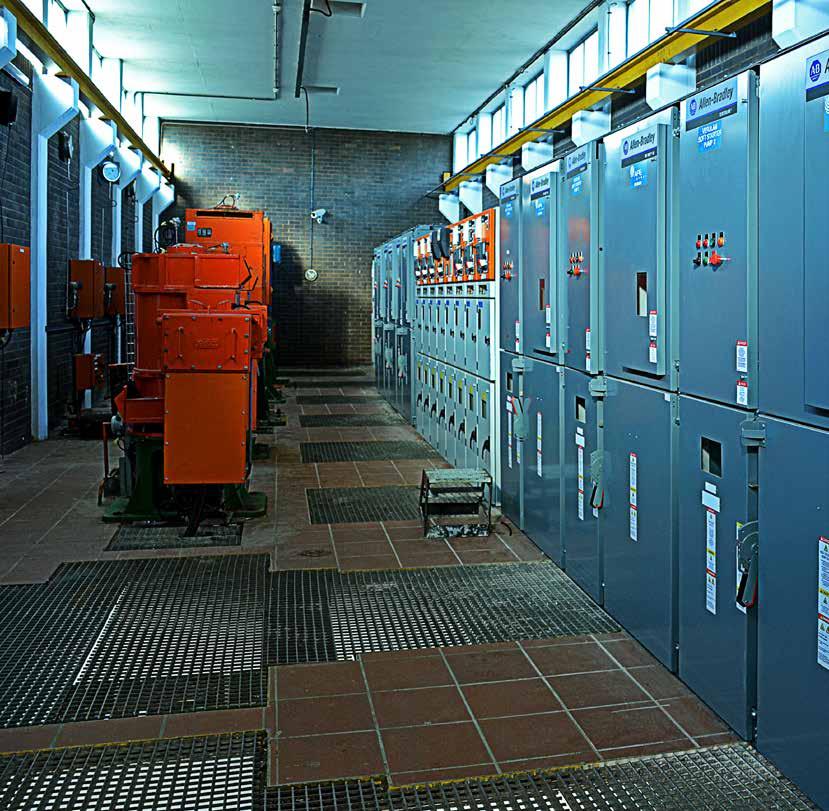
APE Pumps
New mechanical/electrical installation at Verulam and La Mercy Pump Station
Blue Drop and Green Drop programme revitalised
Water Warriors
The water crisis: it’s not a supply issue, it’s a demand one
Holistic approach to industrial effluent and mine water treatment
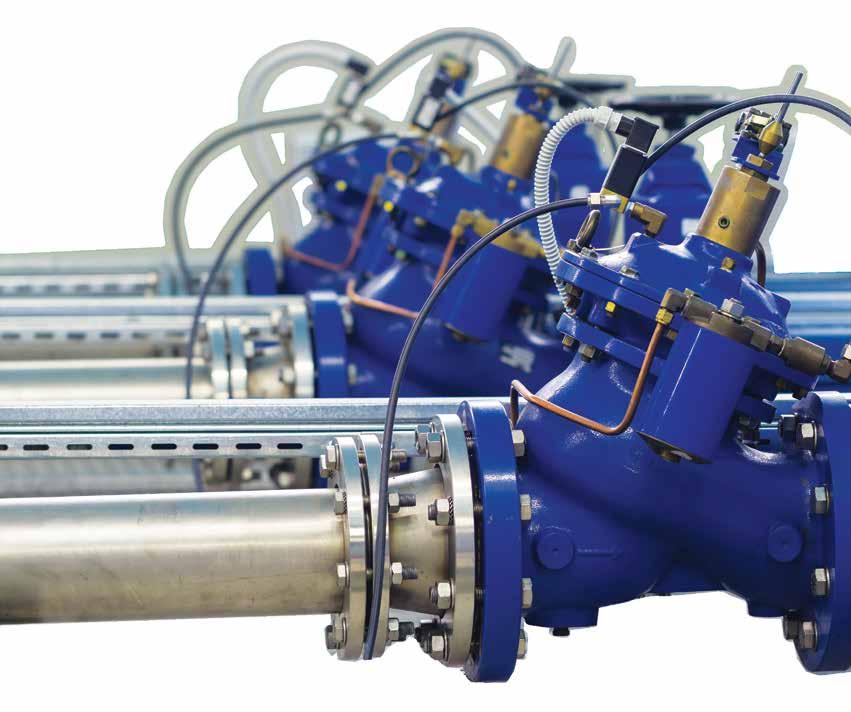
Low or High, Bermad can handle the Pressure
Whether your needs are to reduce, relieve, or sustain, we have the right valves to handle any pressure and keep your business going. Our partnership with Bermad is long-standing and has been one of the ways we keep reinventing ourselves.


Scan the QR Code to get in touch with us and find out more about Macsteel Fluid Control





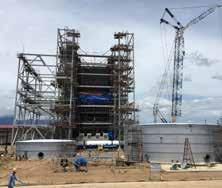

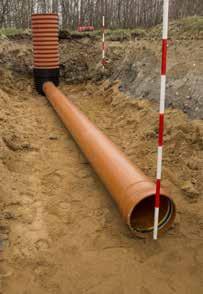
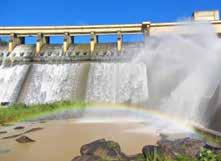

THE FLOW MUST GO ON.
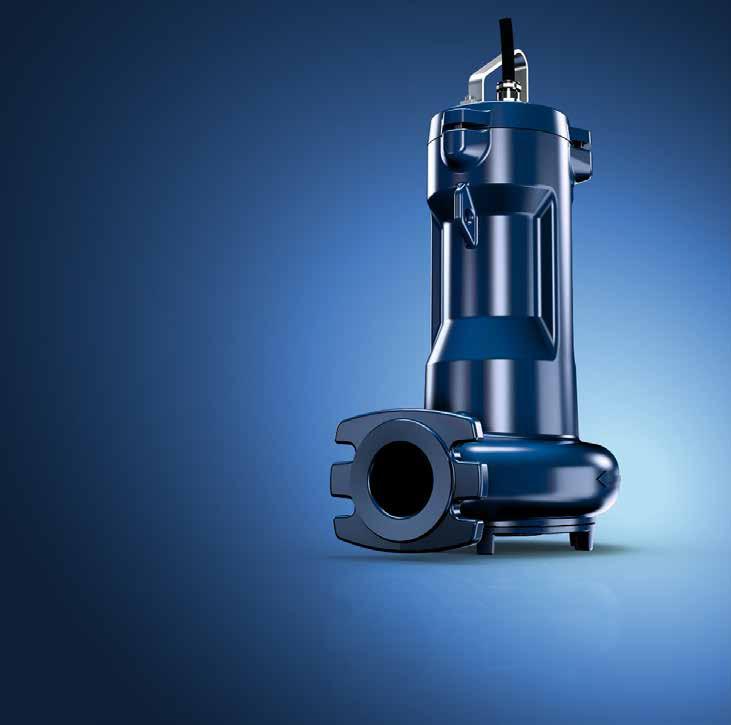
AMAREX - Dual performance submersible pump
Vertical single-stage submersible motor pump for wet installation, with free-flow impeller (F-max), stationary or transportable version. Electrical submersible Motor sizes ranging from 1.1 kW to 10.2 kW.
Applications
- Pumping station
Fluids handled
- Waste water containing long fibre
- Waste water treatment (Including sludge and solid substances treatment and recirculation)
- Municipal and industrial waste water
- Fluids containing gas
- River water transport
- Storm water transport
KSB Pumps and Valves (Pty) Ltd
Tel: +27-11-876-5600
www.ksb.com/ksb-za
Your B-BBEE Partner

- Service water
- Grey water


Editor Kirsten Kelly kirsten.kelly@3smedia.co.za
Managing Editor Alastair Currie
Head of Design Beren Bauermeister
Chief Sub-editor Tristan Snijders
Contributors Xanthe Adams, Lester Goldman, Thandeka Jwara, Chetan Mistry, Kagiso More, Dan Naidoo, Christian Wolkersdorfer
Production & Client Liaison Manager Antois-Leigh Nepgen
Production Coordinator Jacqueline Modise
Distribution Manager Nomsa Masina
Distribution Coordinator Asha Pursotham
Group Sales Manager Chilomia Van Wijk
Bookkeeper Tonya Hebenton
Advertising Sales Hanlie Fintelman
c +27 (0)67 756 3132
Hanlie.Fintelman@3smedia.co.za

Publisher Jacques Breytenbach
3S Media
46 Milkyway Avenue, Frankenwald, 2090 PO Box 92026, Norwood 2117
Tel: +27 (0)11 233 2600 Fax: +27 (0)11 234 7274/5
www.3smedia.co.za
ISSN: 1990 - 8857
Annual subscription: R330 (SA rate)
subs@3smedia.co.za
Copyright 2021. All rights reserved. All articles herein are copyright protected and may not be reproduced either in whole or in part without the prior written permission of the publishers. The views of contributors do not necessarily reflect those of the Water Institute of Southern Africa or the publishers.

WISA Contacts:
HEAD OFFICE
Tel: 086 111 9472(WISA)
Fax: +27 (0)11 315 1258
WISA’s Vision Inspiring passion for water
Physical address: 1st Floor, Building 5, Constantia Park, 546 16th Road, Randjiespark Ext 7, Midrand Website: www.wisa.org.za
BRANCHES
Central Branch
(Free State, Northern Cape, North West)
Chairperson: Dr Leana Esterhuizen
Company: Central University of Technology
Tel: +27 (0)51 507 3850
Email: lesterhu@cut.ac.za
Eastern Cape:
Branch Contact: Dan Abrahams
Company: Aurecon
Tel: +27 (0)41 503 3929
Cell: +27 (0) 81 289 1624
Email: Dan.Abraham@aurecongroup.com
Gauteng Branch Lead: Zoe Gebhardt
Cell: +27 (0)82 3580876
Email: zoe.gebhardt@gmail.com
KwaZulu-Natal
Chairperson: Lindelani Sibiya
Company: Umgeni Water
Cell: +27 (0)82 928 1081
Email: lindelani.sibiya@umgeni.co.za
Limpopo
Chairperson: Mpho Chokolo
Company: Lepelle Northern Water
Cell: +27 (0)72 310 7576
Email: mphoc@lepelle.co.za
Mpumalanga
Chairperson: Lihle Mbatha (Acting)
Company: Inkomati-Usuthu Catchment Management Agency
Tel: +27 (0)13 753 9000
Email: mbathat@iucma.co.za
Western Cape
Chairperson: Natasia van Binsbergen
Company: AL Abbott & Associates
Tel: +27 (0)21 448 6340
Cell: +27 (0)83 326 3887
Email: natasia@alabbott.co.za
Namibia
Please contact the WISA Head Office on admin@wisa.org.za for more information

Great news about energy reform – but what about water?
Although I am an optimist, my optimism is often put to the test when writing about the water industry.
But I remain optimistic, and devour any good news story that comes my way.
When President Ramaphosa announced an energy reform, where the government will amend the Electricity Regulation Act (No. 4 of 2006) to raise the exemption threshold from 1 MW to 100 MW, I did a happy dance. And then my heart dropped when I read his statement: “Our ability to address the energy crisis swiftly and comprehensively will determine the pace of our economic recovery. Resolving the energy supply shortfall and reducing the risk of loadshedding is our single most important objective in reviving economic growth.”
What about water?
Water use and energy supply are inextricably linked. The provision of energy requires water, and energy is often needed to pump, treat or transport water. The need to protect water quality and supply – and the need to ensure a stable and growing energy supply – should hold equal weight. However, the water situation is more dire than the energy situation. Water supply is mostly fixed by nature whereas energy supply is by design. We cannot create water.
Water Warrior
But back to optimism – WASA has created a new permanent feature called Water Warriors. This is an individual/ business that addresses South Africa’s water challenges through corporate stewardship.
The profile will demonstrate how the individual/corporate identifies and reduces critical water risks to their businesses, seize water-related opportunities, and contribute to water security and the UN’s SDGs. I could not have hoped for a better Water Warrior in Gerrie Brink, his company – AQUAffection – and the #SurplusWater2025 movement that they
started. #SurplusWater2025 has saved over one billion litres of water to date! Gerrie is calling on companies to collaborate and work together in tackling the water crisis. Read the story on page 16 and please do join the #SurplusWater2025 movement.
Blue and Green Drop
And then there is more good news: the much-needed Blue Drop and Green Drop certification programme has been resuscitated.
Established in 2009, the incentive-based Blue Drop and Green Drop programmes aimed to raise the awareness of municipalities of good practice in water supply and wastewater treatment. They led directly to many municipalities investing in their water and sanitation staff and infrastructure, and thereby improving their performance. The programmes also generated a wealth of data that enabled the water sector at large to plan and manage the water value chain more effectively. Read more about this on page 52.
Mine water and industrial effluent
We also delve into the very complex and interesting world of mine water and industrial effluent where key players like Knight Piésold, Aquamat and WaterIcon talk about trends and issues facing the industry.
Covid-19
Currently, I am writing this column in my five-year-old son’s room as he is home from school after his teacher tested positive for Covid-19. He has made surprise appearances in my Teams meetings, and taken over my office space by playing drums on my desk. But that inconvenience is small, considering the loss suffered by families and businesses. Please look after yourselves, be kind to each other and stay safe.

COVER OPPORTUNITY



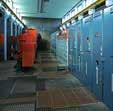
You said it in WASA
The
opinions and
statements
shared by thought leaders in the water industry to Water&Sanitation Africa

“Managers have pushed the pause button on training and capacity building during Covid-19, assuming we can return to a sense of past normality. But organisations cannot afford to put this on hold, as employees need capacity building now more than ever.” Lester Goldman, CEO of WISA


“We have established our whole economy and livelihood around these majestic dam structures, but we can so easily lose them if we don’t apply proper management procedures to keep them in that state.” Leonard Manus, acting deputy director-general: Regulations, Compliance and Enforcement at the Department of Water and Sanitation
18

“We have the president who is lobbying for investment on one side and municipalities that cannot deliver a basket of basic services on the other. Delivering water services is a building block for the reconstruction and development of our country. This is not about building new infrastructure only – it is also about fixing some very basic issues that can make an immediate and significant impact.” Dan Naidoo, chairman of WISA


“Technology has evolved, and the prices of smart devices have decreased. Ripping out all the existing hardware is probably not the best approach. Utilities need to start with a clear strategic plan to create a full ecosystem.” Joyce Moganedi, sales manager: Power and Water at ABB Energy Industries Division


21

“The impacts of climate change are all around us, especially when it comes to water quality and water scarcity. Unless all sectors of society take collective responsibility, we run the major risk of polluting the few resources we have left. That will in turn push up the cost of water purification treatment and compliance, with a resulting financial knock-on effect for industry, mines and their neighbouring municipalities. That’s why it’s critical that mines and industry take full responsibility for their water cycle – from abstraction to treatment and eventual discharge.” Chris Braybrooke, GM: Marketing, Veolia Services Southern Africa


“Everybody is focusing on alternative water sources, building dams, desalination and wastewater treatment. A lot of money is spent on treating water that is then directed into a system that is 80% inefficient. We need to create an efficient system before investing in backup or alternative water sources.” Gerrie Brink, owner and founder of AQUAffection
“Water treatment can be a complex process and requires constant water testing and specialised skills. For example, phosphates found in wastewater can affect some industrial processes, while it will not affect others. A lot of mines can use treated wastewater but need to use better quality water in certain processes. If mines can use wastewater, they often find that they need bigger quantities than those available. Every mine and factory is faced with its own unique challenges with regard to water security and creating zero discharge at a feasible cost.” Leon Naude, section manager: Water Division, Knight Piésold 08


“Individuals and companies are starting to take ownership of their own water security by using tanks provided by Rainbow Reservoirs. We can no longer rely upon rainfall or local authorities for consistent or reliable water supply. Businesses are realising that they need a bulk water reserve for the continued running of their operations during municipal water outages or restrictions. It is imperative that we all do everything we can to save and conserve water.” Quinton Coetzee, director of marketing and business operations at Rainbow Reservoirs





“There is no silver bullet that can fix all your water treatment problems. I have personally seen many ‘white elephants’ where millions have been spent on a plant that is simply not fit for purpose. Every industry is different, and every factory generates different wastewater. Make sure that you have a plant that will work on a bench scale.” Chris Ashmore, general manager, Watericon


“The mining industry is confronted with challenges such as low commodity prices, the increasing cost of electricity and production, and pressures from non-governmental organisations to provide fast and useful monitoring data. These issues are driving the mining sector to Industry 4.0, which leads to industrial transformation. However, the implementation of digital technologies drives an increase in skills demand –resulting in high-quality job creation.” Christian Wolkersdorfer – part of the South African Research Chair Initiative for mine water management at Tshwane University of Technology


“Whether a company is looking to meet stricter limits or improve the quality of its discharge, one of the first decisions it will need to make is usually related to possible treatment options for the water it discharges. This is where a broader approach is valuable, because few water treatment options are completely free of environmental impact.” Xanthe Adams, principal engineer, SRK Consulting

“Effluent seldom remains consistent and its quality should, therefore, be consistently analysed and changes implemented to address any fluctuations. Some clients will have their own laboratories and quality systems in place, while others will contract Aquamat to do all the testing.”
Gavin Mwanza, head: Engineering, Aquamat


“Traditionally, septic tanks are used in rural areas that are far from the metros. A septic tank will break down solids, but it cannot treat water. With septic tanks, there is a high probability that impurities will pollute groundwater. While the National Water Act does not prevent septic tanks from being built, it does specify a level of water quality that has to be reached before discharge, and a septic tank cannot reach that level of water quality. Furthermore, honey suckers are needed to remove wastewater from septic tanks and transport the wastewater to municipal WWTPs. This is costly and often inconvenient. Therefore, many municipalities no longer approve the installation of septic tanks.” Gerhard Cronje, owner and founder, Maskam Water


“Women, children and the elderly dominate rural populations. Many rural communities draw water from undeveloped local sources, creating ample opportunities for crime and intercommunity conflict. Collecting water is also a tremendous time burden, reducing the community's effectiveness. Addressing rural water issues is a direct win for women and children, making them safer and more productive.”
Chetan Mistry, strategy and marketing manager, Xylem Africa


“Everybody knows that bleach is cheap and chlorine gas is cheaper. But is it really? There is a long-held assumption that the cost of a chlorination programme can be determined by comparing the relative cost of the chemical (R/kg), but recent extensive studies have invalidated this perspective.” Peter Buchan, CEO of Control Chemicals

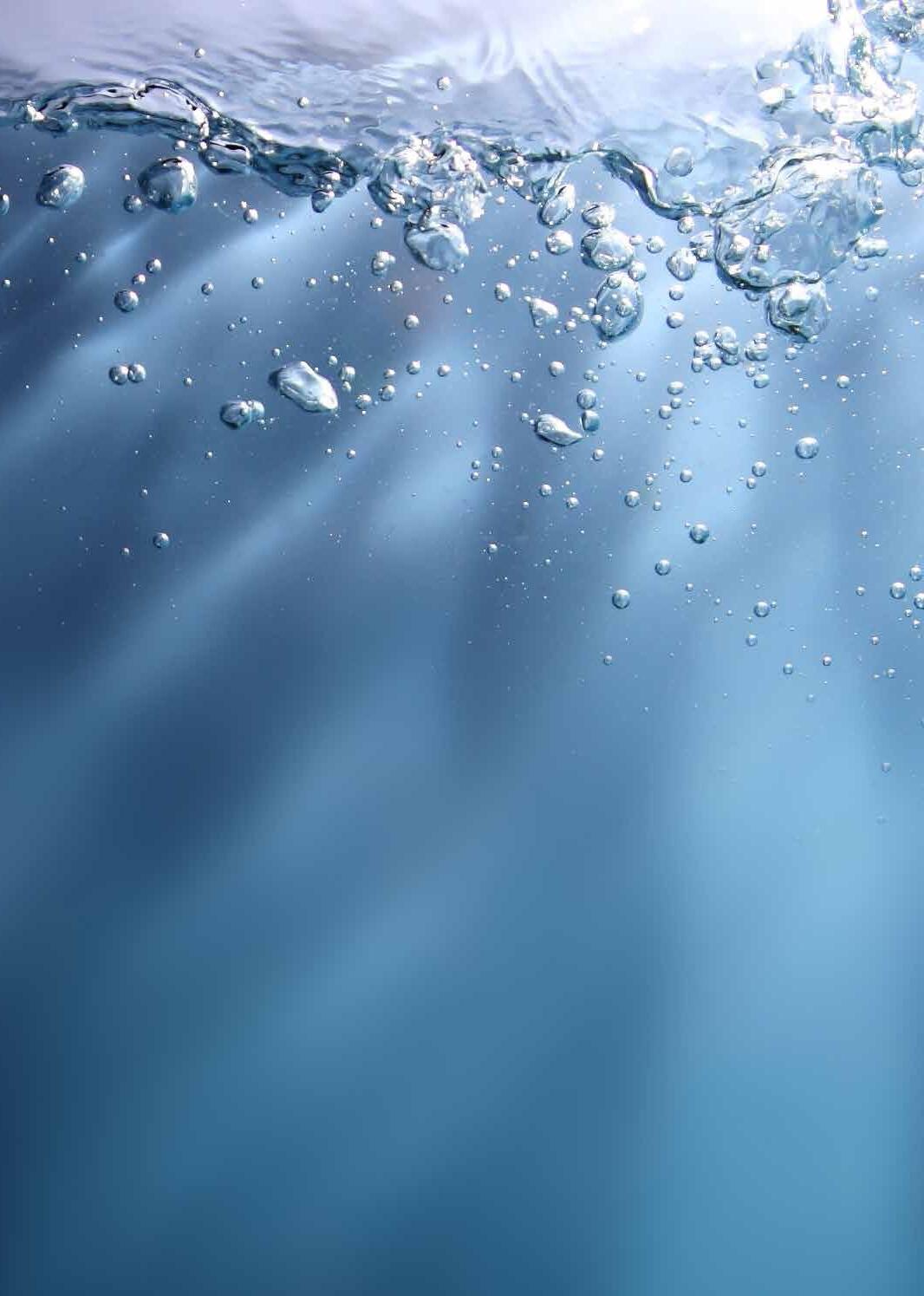

“Typically, we find groundwater in abundance where we don’t need it; and where we need groundwater, we don’t have it. This is due to the complexity of the geology, hydrogeology and variability in rainfall.” Yazeed van Wyk, national treasurer, Ground Water Division


A leader in fluid control solutions, APE Pumps was appointed by Umgeni Water to manufacture, supply, deliver and commission Pump 4 at Verulam Pump Station.
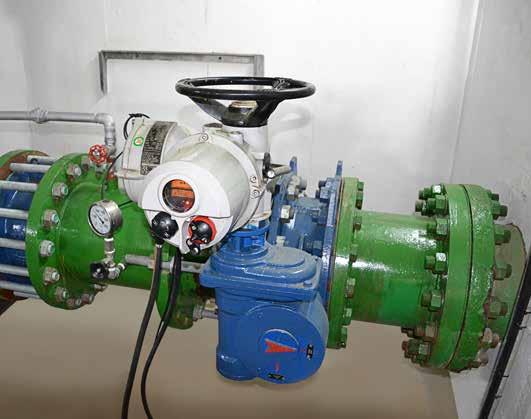
New mechanical/ electrical installation at Verulam and La Mercy Pump Station
Located in La Mercy, the Verulam Pump Station lies within eThekwini Municipality about 27 km north of Durban, close to King Shaka International Airport.
The Verulam and La Mercy Pump Station is part of the Hazelmere Water Treatment Works and has six pumps – four pumps dedicated to the La Mercy area and two pumps for the Verulam area. Water from
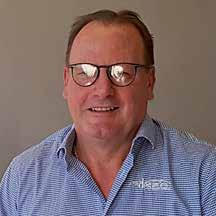
the Verulam side of the pump station is pumped to a holding tank at Grange that distributes to surrounding areas. The La Mercy side of the pump station also acts as a backup to the Avondale Pump Station that supplies Ballito. Water from the Verulam side services a population of 70 000 people.
“APE Pumps replaced a split-case pump with a new vertical turbine pump (APE
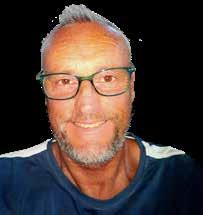
18 HC) – complete with piping, auxiliaries, valves, instrumentation and a motor. The pump was specifically designed to fit into the footprint of the old pump,” says Peter Robinson, a director at APE Pumps who managed the entire project.
Variable-speed drive (VSD)
Pump 4 was fitted with a 650 kW VSD, where, instead of running two pumps in line, only one pump would be used. This is because Pump 4 can deliver in excess of what the two pumps could currently achieve.
“The VSD will help to minimise life-cycle costs because the pumps will not be switched on and off repeatedly. By reducing the pump speed, the water flow is reduced and the reservoir level is maintained. The pump will therefore run for longer at lower speeds and heads. Then as water demand increases, the pumps will run at increased speeds to meet the demand,” explains Robinson.
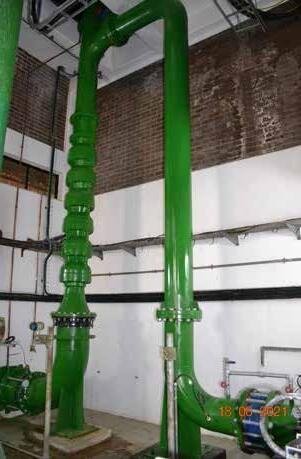
ABOVE Pump suction and delivery lines, manufactured by APE
FAR LEFT Peter Robinson, director at APE Pumps
LEFT Kelwyn Davidson, project manager at OBS
Additional work
After problems were experienced with the switchgear and induction motors, APE Pumps was further tasked with replacing the medium-voltage switchgear from the 6.6 kV, 2.2 kV transformer. Six 500 kW soft starters were installed – an extra one was included for future expansion plans.
The 490 kW motor was replaced with a 650 kW motor and the pumps can run from 1 200 rpm to 1 650 rpm. Auxiliaries and pipe work to Pump 4 were supplied new, as was the instrumentation.
It was important to keep a flow of water to both Verulam and La Mercy. The pump station had to remain functional while the work took place, so APE Pumps worked around the parameters of Umgeni Water.
Avondale Pump Station had operational issues and shutdowns, with La Mercy pumps acting as backup supply.
“Shutting down the La Mercy pumps was not possible, and this required flexibility on the part of all players, with strict adherence to windows of opportunity for shutdowns. These very tight timelines were set to prevent any shortages of water supply to any of the systems and reservoirs.
“We could not shut off the pump station; it is a large system and the taps have to have water in them at all time. We had to carefully plan our work. APE Pumps would cut off a panel and work on one side of an incomer, and transfer cables from one side to the other, so that everything was running on one system. The La Mercy and Verulam areas would be fed by one pump while we worked on the other pump.
We had to take the transformer and the available kilowatts into consideration,” says Robinson.
APE Pumps was responsible for the transportation and offloading of equipment on-site. It was found that the existing crane could not accommodate the weight of the existing and new equipment, so we had to replace it.
During the project, various outside factors influenced the programme of works – the obvious being Covid-19 and the strict protocols in place. Access was restricted at times to the plant at Hazelmere.
Ageing infrastructure and equipment made the transition from the old to new equipment a challenge at times. Two existing Verulam pumps were removed and refurbished, with new valve spools on the delivery lines supplied to eliminate or minimise potential problems in the foreseeable future. A split-case pump was sent to APE Pumps for refurbishment, and the motor was serviced at LHM in Durban. Furthermore, a brand-new APE 18 HC pump and motor was supplied, to ensure a backup pump is always ready to replace Waterloo Pump 2 in the event of any mechanical failures of the refurbished pump.
damage to the pumps and assists with preventative maintenance.
The new La Mercy Pump 4 now produces between 600 m3/h and 1 100 m3/h, and 24.6 Mℓ/day, working on the VSD.
Contract Participation Goals
“APE Pumps has been fortunate enough to work with OBS Mechanical Electrical Turnkey Projects, a Level 1 BBBEE company, for transformation purposes. We trained a number of young people during the manufacture, installation and commissioning of Pump 4,” says Robinson.
Kelwyn Davidson, project manager at OBS, says APE Pumps and OBS have developed a seamless partnership.
“Furthermore, Umgeni Water was fantastic to work with – they embraced suggestions to improve the basic day-to-day running of the systems and methodology to safeguard the ageing equipment. Everyone worked as a team. I look forward to future projects with both APE Pumps and Umgeni Water.”
OBS has already partnered with APE Pumps on a number of Umgeni Water projects. The company has expertise in many areas of engineering, along with water movement and treatment.
Instrumentation was installed on all pumps to evaluate pressure, vibration and temperature, as well as a humanmachine interface (HMI). The pumps will automatically be turned off when their pressure, vibration and temperature move outside set parameters. This prevents serious www.apepumps.co.za
APE VERTICAL TURBINE PUMPS
Manufactured locally, APE vertical turbine pumps have the following features:
• Civil work is easier and cheaper
• Installation is easier
• There is no suction valve, with consequent cost and pressure-loss savings
• Efficiencies are good
• Net positive suction head (NPSH) problems are eliminated
• Space is saved and, by using weatherproof motors, no need for a building to be erected
• There is no danger of flooding the electrics
• By adding stages, a very wide range of duties can be covered with standard parts, thus making for cheap and readily available spares
• The pumps generally have a non-overloading kW characteristic, and a steep head quantity curve
• There are no radical loads on the bearings or glands, so they last longer and maintenance is reduced
• In dirty water, grit tends to fall vertically out of the wear areas and so does less damage


Do not put training on hold
Managers appear to have put training on hold during this pandemic – stunting organisational resilience and capacity building. By Dr Lester Goldman
Covid-19 has had a devastating impact on our sector and communities. Thrust into a third wave currently, we pray that we are able to overcome, and that lives are spared. During this Covid-19 phase, many have managed to become tech-savvy, and adept at Zoom, Teams and so forth. Lockdown and working from home have become second nature to some, and even improved the efficiency rate of many.
Unfortunately, we have seen one area lagging – and that is training and development. Managers seemingly have pushed the pause button on training and capacity building, while assuming we can return to a sense of past normality. However, organisations cannot afford to put this on hold, as employees need capacity building now more than ever.
Digital technology, resilience, coping skills and other soft skills may be the
very crutch your staff need, and now they may not be able to access it due to working remotely. Strategically, this period could be a valuable one spent developing and improving staff capacity and developing organisational resilience. Capacity building in areas like learning responsiveness, adapting delivery, exploring digital strategies, and multiple outcomes development can improve your business and competitiveness, for an eventual postCovid-19 world.
Evolution of capacity building History shows that training and capacity development have evolved through decades. From the Industrial Revolution of the early 1900s, where the fundamentals of on-the-job training were developed and are still practised, to post-war booms where efficiencies were emphasised. The 1960s brought new a civil focus globally, which also changed development focus to

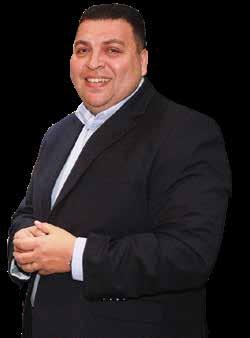
Dr Lester Goldman, CEO, WISA
leadership and personal development. The 1980s brought an IT revolution, with many of us having to learn new skills, just to be able to communicate effectively in the workplace, and the 1990s introduced widespread internet – ensuring we became global players to remain relevant. The 2010s brought about social media and learning, and development focused on marketing and communications in a whole new way.
Covid-19 will probably be the stimulus for a whole new way and focus of doing business, and capacity building during the 2020s. Almost certainly, it will be virtual, as platforms developed are expanded and improved, and the time benefits are integrated into business. Hence, lockdown becomes a period of opportunity for early adopters and adapters of virtual training.
Gaining a head start for your organisation and employees, in this undoubtedly new stage of capacity development, brings huge strategic opportunity. I hope that this can be leveraged, to ensure that post-Covid, you leap from lockdown, even more empowered and capacitated than ever. If you need any assistance in this regard, please do contact us at WISA (training @wisa.org.za). We can assist in crafting online capacity building for your organisation, professionals and employees.
Please stay safe, practise collective responsibility in fighting the effects of this virus, and I wish you continued health and blessings!
TIME TO ACKNOWLEDGE THE ECONOMIC IMPACT OF WATER

According to the latest local government audit outcomes report, 27% of South Africa’s municipalities say they don’t know if they can continue – and almost one in four councils, or 57, failed to deliver any kind of financial statement by the statutory audit deadline.
By now, we all know the story about how a small local municipality (Emfuleni) posed a significant threat to the Vaal River System – one of the most strategic water assets in the country and on the African continent.
After a damning ruling by the South African Human Rights Commission (SAHRC) and a consequent R8 billion intervention by the Department of Water and Sanitation (DWS), there is a chance that the Vaal River System situation will be improved.
Holding authorities to account
Then there is a story about how a poultry producer, Astral Foods, took Lekwa Local Municipality to court over the non-delivery of basic services – and won. Government will be required to intervene in Lekwa and, together with National Treasury, prepare a financial recovery plan. The order also provides for Astral to approach the court again for further relief, if it is of the view that the financial recovery plan is not being implemented.
Another story features dairy group Clover, and the fact that it is shutting down its factory in Lichtenburg over similar service delivery failures – and opting to shift its operations to Durban instead. This showcases the economic impact that a lack of water delivery has on surrounding areas.
The problem is, if all businesses move to areas with better service delivery, there is an additional burden placed on already water stressed areas, while negatively impacting on the local economy it leaves behind. It is not a sustainable solution for all affected parties.

The current situation is dire and there is little doubt that our municipalities are failing to deliver water.
We have the President who is lobbying for investment on one side and municipalities that cannot deliver a basket of basic services on the other. Delivering water services is a building block for the reconstruction and development of our country. This is not about building new infrastructure only – it is also about fixing some very basic issues that can make an immediate and significant impact.
Immediate action
Our industry requires a high level of intervention and immediate action. There are brilliant professionals in the sector and I firmly believe that solutions to the water crisis lie within the membership of WISA and our other professional bodies.
By Dan Naidoo, chair, WISA
We need to understand how to elevate the discussion around water at its most basic and impactful level. How do we communicate this risk better, with our stakeholders and citizenry? How do we start to do things differently to avert the major crisis we know is looming?
We all need to get our hands dirty and start to fix the problems facing our industry, but only if we are allowed to do what we are good at in a multidisciplinary team effort in a compact with our communities and citizens.
Meet some of YWP’s water change-makers
We would like to introduce you to a few young professionals contributing to the present and future needs of the water sector in South Africa.
NKOSINATHI BUTHELEZI
Nkosinathi grew up in rural KwaZulu-Natal and has been an active professional in the water sector since 2012. He holds a chemical engineering degree, an honours degree in water utilisation, and a master’s degree in commerce and leadership studies. Nkosinathi has worked for eThekwini Municipality, where he started his career in the R&D Department, as well as Mhlathuze Water Board, working as an engineer. He is currently employed by the Department of Water and Sanitation as a chief engineer and area manager for the Tugela Vaal Government Water Scheme. He is a registered professional with the Engineering Council of South Africa and a project management professional with the Professional Management Institute. Goals: To work towards ensuring that more and more of our rural communities get

access to water for various uses – especially agricultural and domestic uses. This is particularly important to him as he grew up in the same environment. Working to make sure that water benefits our most vulnerable communities is a huge motivation for Nkosinathi. Message to young professionals: “The ball is in our court. Young professionals need to be professionally active in our societies in order to make a meaningful impact on the socio-economic landscape of this country. I believe there is scope and opportunity for young professionals to play a more direct role in the betterment of our communities.”

ODWA NTSIKA MTEMBU
Born and raised in rural Eastern Cape, Odwa is a climate change activist, social entrepreneur and a young professional practising in the field of climate, water and applied geomorphology. He has obtained a BSc Hons Environmental and Geographical Science and BSc Geology, Environmental and Geographical Science. Odwa is passionate about working towards inclusive and innovative sustainable solutions to build smart and self-sustainable cities. He is the founder of World Merit SA and, through his volunteer work in this platform, has managed to link community development and connect young people
MBALI SIBAYA

Mbali hails from the south of Durban where she grew up and went to school. She is an employee of Umgeni Water and has 10 years’ experience in the water sector. With a BTech Chemical Engineering (Environment), Mbali was selected in a group of 20 women to be part of an Executive Development Programme: Women in Leadership at Wits University. She is a mother to four children and an active young water professional, where she now serves as the YWP-ZA Transformation Lead. Mbali is a member of the WISA Process Controllers Division, where she advocates for the transformation of water treatment processes and inclusivity of process controllers in the sector. Mbali has presented her work at international and national conferences in the sector, is a member of the Water Youth network, as well as the Women in Water and Sanitation Network. She is an advocate for women rights and the SDG 6 agenda.
Goals: To play an active role in ensuring water for all by 2030. To be impactful in society in encouraging and inspiring youth involvement in a transformed South Africa in governance, ethics and sustainable life for all.
Message to young professionals: “This year marks 45 years since the 1976 student uprising in Soweto. A significant year of transformation change and great challenge to leadership in our country. We must challenge ourselves to be transformational and impactful leaders in all spheres of our world. Let us be beacons of hope and life in our communities and form progress partnerships that will enable us to be instrumental in growing youth employment for an inclusive and transformed society. As the struggle for equal education was the battle that the youth of 1976 had to fight for an die, let us continue the struggle for economic emancipation in their honour.”
to opportunities from around the world. Odwa is a registered scientist with SACNASP and is employed by the Department of Water and Sanitation. Goals: His passion and purpose are rooted in his ethical duty to serve his community.
Message to young professionals: “Young professionals in the sector have the skills, experience and knowledge to tackle local to global issues and connect everyone to opportunities through our networks with the resources we have in our communities and organisations. As we continue to lead, research, innovate, implement, monitor and
evaluate our work in the sector, let us not forget to ensure transformation, transparency, progress, accountability and sustainability.”


DR LLOYD FISHER-JEFFES
Dr Lloyd Fisher-Jeffes is a graduate from the University of Cape Town and currently working as a registered, professional civil engineer with a specific interest in the design, management and planning of water resources. A member of WISA, South African Institution of Civil Engineers (SAICE) and International Water Association (IWA), Lloyd is a co-winner of the CESA Young Engineer Award in 2020.
Goals: To play a role in developing and improving the practice of sustainable urban engineering, with a specific focus on the management of water resources in Southern Africa.
Message to young professionals: “The water sector offers young professionals the opportunity to make a huge positive impact on people’s lives. Be one of the diverse, energetic and exciting people to make a water sector that South Africa can depend upon.”
YWP holds webinar between South African and Japanese water sectors
Protecting and maintaining water distribution systems is crucial to ensuring high-quality drinking water. By
Thandeka Jwara
Distribution systems consist of pipes, pumps, valves, storage tanks, reservoirs, meters, fittings, and other hydraulic appurtenances that carry drinking water from a centralised treatment plant to consumers’ taps. Therefore, distribution is an important part of the value chain and requires adequate monitoring and management to ensure sustained access to water and customer relations.
Webinar
The YWP recently held a webinar between eThekwini’s Water and
Sanitation Department, Umgeni Water and the Yokohama Waterworks Bureau in Japan.
Presentations were kicked off by an Umgeni Water and eThekwini Water and Sanitation representative who gave an overview of the organisation, the water distribution management strategy, as well as its water supply services. South Africa – and KwaZulu-Natal in particular –faces challenges with non-revenue water through illegal connections or unregistered customers.
Customers in rural areas where the service level is such that they consume 6 kℓ of free basic water tend to tamper with infrastructure in order to gain full pressure supply. Other consumers bypass meters to avoid billing,



while some reconnect their supply (illegally so) after being disconnected for non-payment.
Japan representatives, however, claimed that they do not have such challenges, as most of their customers are billed. They alluded to the fact that their effective system performance is due to the integration of technology for most, if not all, of their distribution and demand management infrastructure. This was a key highlight, as KZN has ageing infrastructure and faced an estimated 45% of non-revenue water in the 2018/19 financial year.
The session remains available on YouTube for live-streaming and more conversations of a similar nature are envisaged for the future.

Population growth, rising per capita water consumption, and increasing environmental protection efforts have increased pressure on the world’s freshwater resources.
Why social data matters
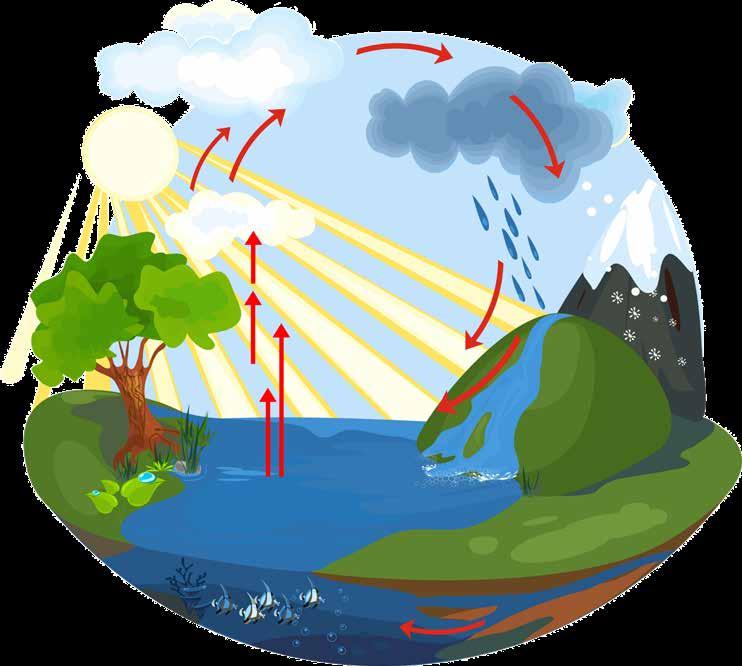
The hydro-social cycle, rather than the traditional hydrological cycle, identifies social power and structures, inequality in water provision, and institutions and governance processes that shape the outcomes of water management
While water management has been framed predominantly as a technical field informed by natural science and engineering expertise – and addressed through infrastructure provision – it also has a social and political dimension that involves power relations, human values, behaviour and attitudes, providing a broader context for water management and governance.
The hydro-social cycle promotes a critical analysis of water-society relationships, positioning humans within the hydrologic cycle, where society and water outcomes are shaped by complex interactions between social, political, historical, economic and hydrological factors.
“The hydro-social cycle, rather than the traditional hydrological cycle, identifies social power and structures, inequality in water provision, and institutions and governance processes that shape the outcomes of water management. Social data relating to the hydro-social cycle helps to create just and transformative sustainability in our water and sanitation systems,” explains Cathy Sutherland, associate professor from the University of KwaZulu-Natal, who has recently joined WISA’s new Modelling and Data (MAD) Division to support the production and use of social and governance data.
How is social data used?
The Blue Diversion Autarky toilet, developed by Eawag in Switzerland, is a sanitation system that does not rely on water and wastewater infrastructure. It was tested as part of the Bill and Melinda Gates Foundation’s Reinvent the Toilet Challenge in a single peri-urban household in Durban, as the only form of sanitation for three months. The effectiveness of the toilet was measured from both a technical and social perspective. The social acceptability of the toilet, which is key to its success, was determined by ensuring that household members played a central role in the coproduction of knowledge around the functioning and social acceptability of this innovative sanitation system.
In another project, the Blue Diversion Autarky handwashing station, developed by Eawag and EOOS in Austria, was tested in an informal settlement in Durban for three months. The water treatment system recycles handwashing water,
which means the station can operate independently off the grid.
Residents of the informal settlement, who had been trained by researchers from KwaZulu-Natal, collected data on the use of the system, to determine the community response to and acceptability of the system. This local knowledge (social data) assists scientists and government officials in developing a better understanding of the effectiveness of innovative water systems that address water scarcity and the lack of access to largescale infrastructure.
Social data has also been collected on water and sanitation services across different informal settlements in Durban, including surveys on the satisfaction of informal settlement residents of communal sanitation facilities. The results of the surveys reveal high use of the communal ablution blocks (CABs) – the multiple ways in which they are used, including for sanitation, water collection, showering and laundry – but also the significant challenges of the system in providing dignified and safe sanitation.
Within the Palmiet Catchment Rehabilitation Project, river rehabilitation is being supported through a community-based partnership where ‘EnviroChamps’ report sewage outflows on a smartphone app that provides data to the municipality. Community members, through their collection and transfer of data have become social agents of change.
Big data platforms
Expert and experiential knowledge is therefore informing more sustainable water management. “This localised data needs to be brought into big data platforms so that it can make a difference. We are currently working with Dublin City University, in association with the European Space Agency, to develop a big data platform to monitor the functioning of CABs so as to manage risk,” says Sutherland.
Dublin City University aims to use technical data from satellites, sensors in rivers to detect pathogens, sensors on CABs and waste treatment plants, weather data, clinical data, and apps that track service vehicles in order to build an integrated data platform to monitor sanitation provision and safety. These researchers are working with the WASH R&D Centre at the University of KwaZulu-Natal, which Sutherland and her team are a part of, to bring social data (like a user’s perception of CABs, attitude to using CABs and civic science) into the new big data platform.
“It is new work that we are involved in. I am excited to learn from this and contribute to other social data projects in the water and sanitation space,” adds Sutherland.
Social science in water Sutherland states that social science brings different kinds of approaches and methodologies, as well as different forms of data. “It is critical to integrate engineering data, natural science data, and social science data for improved water governance and management – to ensure the provision of safe, accessible, dignified, and affordable water and sanitation services for all.”
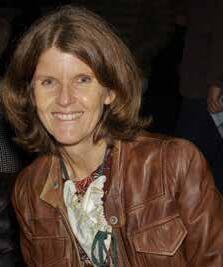
Cathy










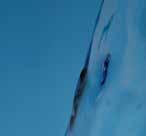
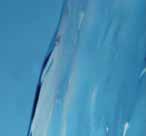



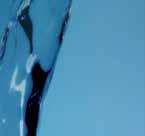
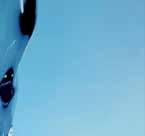



www.veolia.co.za
Generous donation makes breathing easier for South African asthma patients
There are thousands of examples of kindness and empathy displayed by ordinary South Africans during the Covid-19 pandemic. WISA and Grundfos were among the corporates and non-profit organisations that used their resources and expertise to mitigate the devastating impact of the pandemic.
At the height of lockdown in 2020, there was a dire shortage of personal protective equipment. N95 masks, in particular, were in short supply.
Jaco Seaman, marketing and events manager at WISA, is a 3D printing hobbyist and belongs to a 3D printing hobbyist group. He says that through a coordinated effort, the 3D printing community members used their expertise, their time, filament and skills to print the N95 masks.
“The idea was to stretch resources. So instead of wearing an N95 mask for one day, we designed an N95 mask that could be worn for nine days. We printed thousands of these masks. Emergency Management Services picked up these masks from our houses (as they were the only people who could drive around at all times during hard lockdown) and distributed them wherever needed,” he says.
Eventually, the 3D printers ran out of filament and the group was unable to import anything. A local company, AMS, offered to locally manufacture the
printing filament at cost; however, many of the people in the group could not afford to keep buying filament at these huge quantities.
“Our group started to ask for donations; however, no one wanted to take responsibility for the money, as we were not a registered company. WISA stepped in to handle donations and the Grundfos Foundation in Denmark allocated an amount of R270 000. But, by then, the need for the 3D printed masks had run its course, so WISA and Grundfos set out to find another life-giving project into which the money could be channelled.
AfriSpacer
“We assessed a number of projects, and the one that we decided to support is the AfriSpacer – a simple, low-cost attachment for a plastic bottle that can be used with a traditional asthma inhaler to increase its effectiveness,” says Peter Mashaba, facilities supervisor: SSA for Grundfos South Africa. “It ties in with the intent of the donation – providing funds
that will save lives, particularly during the Covid-19 pandemic.”
The need is huge – at 15 000 lives lost each year, South Africa has one of the highest asthma death rates in the world. As many as 80% of these deaths could be prevented with better treatment and access to medicine.
The AfriSpacer attaches to one end of a plastic bottle, with the patient’s inhaler attached to the other. Medication is pumped from the inhaler into the empty chamber of the bottle and the patient breathes it in, allowing the medication to reach the lungs without spraying micro droplets into the air. A key feature of the AfriSpacer is its one-way valve system –the AfriValve – which can be washed and reused, making it a safe, effective and durable product on a par with more costly commercial asthma spacers.
The AfriSpacers are being distributed by the Allergy Foundation South Africa (AFSA), whose CEO, Professor Michael Levin, is head: Allergy at the Red Cross War Memorial Children’s Hospital in Cape Town.
“We’ve been using the spacers for more than 20 years, but it was only recently that an affordable and scalable solution was developed,” Levin says. “Then the challenge became finding the funds to produce them at the scale we need – which is where the very generous donation from Grundfos is going to make such a difference.”
A key feature of the AfriSpacer is its one-way valve system – the AfriValve – which can be washed and reused, making it a safe, effective and durable product on a par with more costly commercial asthma spacers
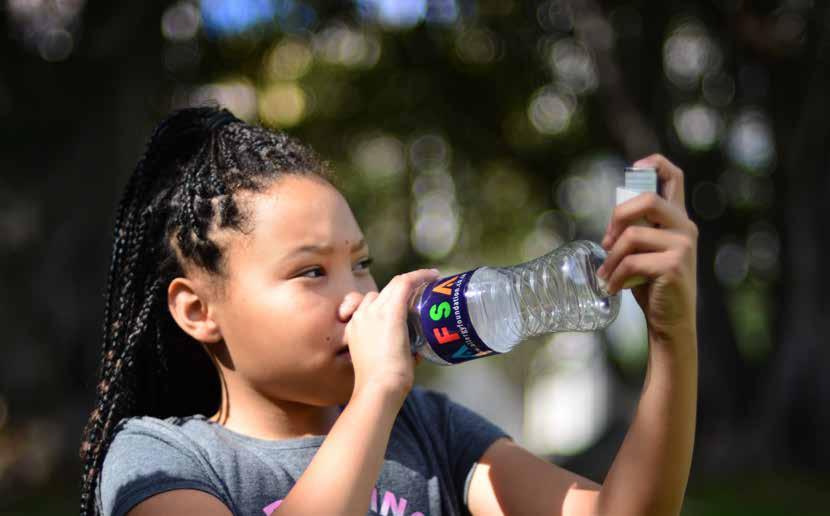
WARRIORS
Our very first Water Warriors feature introduces Gerrie Brink, his company –AQUAffection – and the #SurplusWater2025 movement that they started.
The water crisis: it’s not a supply issue – it’s a demand one
With a growing global population, the demand for potable water increases daily. South Africa has moved from a water-stressed country to a water-scarce one. It is predicted that South Africa will form part of the ‘extreme scarcity’ category by 2025.
When I heard this prediction, I started to think about what could be done to turn South Africa’s water situation around. We cannot simply sit around and accept that South Africa will fall into the ‘extreme scarcity’ category. We have to do something now,” says Gerrie Brink, managing director of AQUAffection.
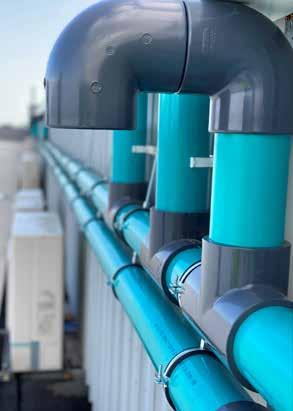
Over one billion litres of water saved #SurplusWater2025 is an initiative born out of Brink’s vision to effect positive change in South Africa’s water industry. To date, 31 companies have joined the movement, 473 meters have been installed, and over a billion litres of water have been saved. The current daily savings are running at close to two million litres, with this number growing as more companies join the movement.
“The movement is about collaboration. It is about pooling resources together. I believe that if everyone focuses on their core expertise, we can make a far bigger impact in a shorter amount of time. We need to stop competing with each other and start complementing one another. #SurplusWater2025 is about sharing knowledge,” explains Brink.
Monitoring
“It all starts with monitoring – you cannot manage what you cannot measure. Water meters are a form of measurement, but they are a snapshot where a reading is taken at the beginning and the end of a month –giving a total consumption of water in a month. It does not give insight into what makes up the water consumption (toilets, irrigation, water coolers, etc.) or when there are peak flows, or how much water is used during a particular period in the day.”
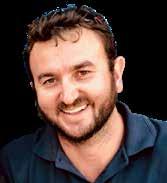
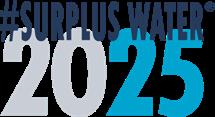
AQUAffection researched a number of monitoring tools. “There are many hardware and software options, but they seldom integrate seamlessly with each other. We then found WRP Consulting’s Zednet water demand management solution. It can show different parameters (tank levels, rainfall, flow patterns, borehole water, quality monitoring, electricity consumption) on the same display. It is customised to the needs of our corporate clients,” adds Brink. By using the monitoring tool, all water savings are easily reported daily, and
SOME OF THE COMPANIES TAKING PART IN THE #SURPLUSWATER2025 MOVEMENT
• Atterbury
• Attacq
• ADvTECH
• Emira
• Steenberg
• Fortress
• OUTsurance
• We Buy Cars
• SBS Tanks • WRP Consulting • Rainbow Reservoirs • Moolman Group

a cumulative number displays savings since the start of the project. This assists corporates in calculating money saved versus money spent on water saving initiatives. The water savings contribute towards the #SurplusWater2025 initiative.
The DROP Approach
AQUAffection uses the ‘DROP Approach’ when tackling a water problem.
1) Data: Collect all relevant information/ data to determine historic daily demand of the site. Understand history of water demand from water bills and meter readings. AQUAffection determines if the site can save water. This also establishes the baseline against which future demand will be measured to calculate savings.
2) Refine: Install electronic monitoring devices – also called automatic meter reading devices – to refine and better understand the site’s water demand profile; monitor site consumption to determine flow profiles and demand.
3) Options: Determine the options to lower demand (leaks, efficiency devices, system optimisation), as well as options for backup systems and alternative sources.
4) Proceed: Proceed with the implementation of the identified options.
“DROP forms a continuous loop to reduce the water footprint. For example, once a leak is repaired, then data is collected and the whole process starts again. We aim to achieve the biggest impact with the lowest capital outlay and without impacting on anyone’s comfort levels.”
AQUAffection first works towards reducing the client’s water demand before
setting up backup or alternative water sources. This ensures a lower-cost backup system, as it is always smaller than initially estimated – corporates therefore save money, mitigate risk and are more sustainable.
“Everybody is focusing on alternative water sources, building dams, desalination and wastewater treatment. A lot of money is spent on treating water that is then directed into a system that is 80% inefficient. We need to create an efficient system before investing in backup or alternative water sources,” adds Brink.
Training
“We offer training because the water crisis is not a technical problem; it is caused by human behaviour and a lack of knowledge – you don’t know what you don’t know. There needs to be greater awareness around water and more education on the topic. AQUAffection provides training on the extent of the water problem in South Africa and gives information on what each person can do to address it,” explains Brink. Security guards, cleaning and maintenance staff, as well as facilities managers and operational and administrative employees, all receive different types of training so that everybody is working towards reducing water consumption. They are taught to identify and fix malfunctioning toilets and leaking taps. Often, corporates use their skills development budget to fund the training component. There is also a focused training for top management on designing a sustainable water strategy.
Patented flushing mechanism
Brink did an MBA at the University of Stellenbosch Business School with a research paper on ‘Factors influencing water demand in commercial buildings’. “If there are no cooling towers or water irrigation, 90% of water consumption is from toilets. And if a mechanism gets stuck in a toilet, it can flush over 700 litres an hour. This is why AQUAffection has developed a patented outlet valve mechanism together with Dutton Plastics Engineering, which is available at various outlets like Plumblink and Chamberlains.”
Tests have shown that, by changing the outlet valves on all of the toilets, one can

reduce water in commercial buildings by up to 80%.
“This is what I mean about collaboration – if AQUAffection decided to manufacture the outlet valve ourselves, it would have taken years to bring it to market. But by working with Dutton Plastics Engineering, we can readily use the outlet valve now while focusing on our core business – reducing water consumption in commercial buildings,” says Brink.
With the calculated water savings and available data, AQUAffection is influencing greenfield projects too. It has a dedicated Wet Services Department that takes everything learned from AQUAffection’s retrofit projects and assist developers and architects with water-efficient buildings.
Ifyouwanttojointhe #2025SurplusWatermovement,visit: https://surpluswater2025.com.
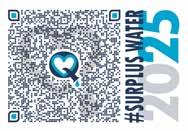

Increasing dam storage capacity through the NatSilt Programme
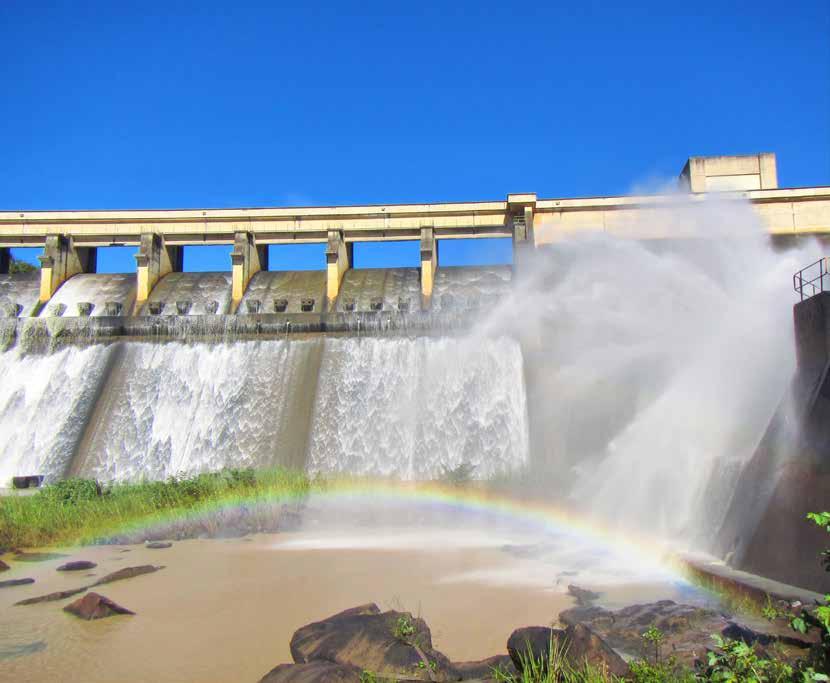
South Africa has a history of building dams to address water security needs and to provide essential bulk water supply to its population. Several large dams are steadily losing storage capacity each year due to soil erosion and land clearance, with many smaller farm dams now full to the brim with silt.
Dams disrupt normal surface water and sediment flow, leading to sediment being trapped and unavailable for essential downstream ecosystem functioning. This can lead to erosion and ultimately reduce a dam’s water storage capacity over time. Sedimentation rates in South Africa are extremely high. One of the country’s worst-hit large reservoirs is the Welbedacht Dam on the Caledon River in the Free State – which has lost more than 90% of its storage capacity due to siltation. In 2016, the CSIR estimated that South African national dam storage capacity loss due to siltation was 10%. This reduction threatens water security, which threatens food security,
ecosystems, and economic progress in the country.
National Siltation Management Strategy
In response to this, the Department of Water and Sanitation (DWS) has appointed the Water Research Commission (WRC) to develop the National Siltation Management Strategy for Large Dams (NatSilt Programme). This will represent a collaborative, transdisciplinary approach to tackle the wide spectrum of dam sedimentation and storage capacity challenges in South Africa.
The NatSilt Programme is initiated and funded by the DWS through its Infrastructure Build, Operate and Maintenance (IBOM) branch, which is responsible for the asset management and infrastructure maintenance of 276 government water schemes across the country, including 320 large state dams that make up more than 90% of the country’s total storage capacity.
Occurring in three phases over three years, the NatSilt Programme is expected to be concluded in 2023.
The WRC will be developing a package of siltation management solutions that include relevant tools, models, frameworks, protocols, guides and plans in order to assist with the implementation and monitoring of the strategy. This will help the DWS in ensuring sustained supply to domestic, industrial and agricultural bulk water users, as well as save scarce financial resources by extending the life cycle of existing dams. Among the vital insights that have been gleaned so far include the role municipalities play in the maintenance
of the catchment areas and how crucial it is that there is cooperation between the various government departments in ensuring the programme’s success.
“We have established our whole economy and livelihood around these majestic dam structures, but we can so easily lose them if we don’t apply proper management procedures to keep them in that state,” says Leonardo Manus, acting deputy director-general: Regulations, Compliance, and Enforcement at the DWS. Manus adds that the NatSilt Programme will provide the department with the tools and intelligence to make appropriate, site-specific decisions regarding each dam, instead of using a blanket approach. “Where sedimentation occurs to such an extent that it has to be dealt with, we will create a business model that will not be to the detriment of those who are dependent on the dam. To minimise costs to the downstream users in that specific catchment, we need to find alternatives to expensive methodologies and dredging models deployed to keep any dam operating.”
A coordinated approach
For dam siltation management to be successful, the efforts need to
The release of large volumes of muddy water can inundate riverbeds and drastically effect downstream ecosystems if not properly planned
We have established our whole economy and livelihood around these majestic dam structures, but we can so easily lose them if we don’t apply proper management procedures to keep them in that state.”
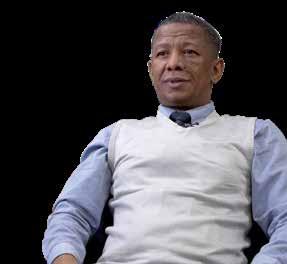
address the state of the existing dams, how they should be operated and the activities within their respective catchments. While addressing dam engineering components of dam siltation management, it is equally important to address the socio-ecological systems aspects of it.
Among the components of dam siltation highlighted by the programme implemented by the WRC is the development of a dam classification framework and dam operations model. The classification framework aims to classify dams from exhausted to sustainable and subsequently inform the development of the operations model. The dam operations model will recommend strategies suitable for operating specific dams.
Dam engineering has an important role to play in safeguarding water security.
However, the design and construction of these dams need to consider their impacts on society and ecological systems. The way in which this has been done in South Africa has resulted in dam siltation not being managed adequately. This can be attributed to the inconsistent monitoring efforts and lack of holistic approaches when dams are being designed and constructed. This negatively affects the lifespan of the dams.

At a global level, concern is growing about declining dam storage levels due to siltation, increased human populations, urbanisation, as well as exacerbated storm erosion linked to climate change. “By 2050, roughly 64% of the world’s current reservoir storage capacity could be filled with sediment.” says Professor Gerrit Basson, who is head: Hydraulic Engineering at Stellenbosch
THE KEY DELIVERABLES OF THE NATSILT PROGRAMME ARE TO DEVELOP:
• A dam basin siItation management operations model
• A sustainable dredging business model/s
• A dam basin classification decision-making tool
• Capacity-building
• A step-by-step comprehensive implementation plan and piloting of the draft strategy, models and tools
• A pilot plan potentially rolled out in three government water schemes – Welbedacht Dam in the Free State, Hazelmere Dam in Kwazulu-Natal, and Darlington Dam/Orange-Fish GWS in the Eastern Cape

WATCH
A VIDEO SUMMARY OF THE NATSILT PROGRAMME HERE:

https://www.youtube.com/watch?v=7BOtiQlMm6o
For additional information or programme enquiries, contact:
• Lesego Gaegane, senior project manager: National Dam Siltation Programme, WRC: lesegog@wrc.org.za
• Vuyokazi Matiwana, project officer: National Dam Siltation Programme, WRC: vuyokazim@wrc.org.za
Because of the massive cost of building new dams, the problem of siltation has to be tackled swiftly to extend the lifespan and capacity of existing infrastructure
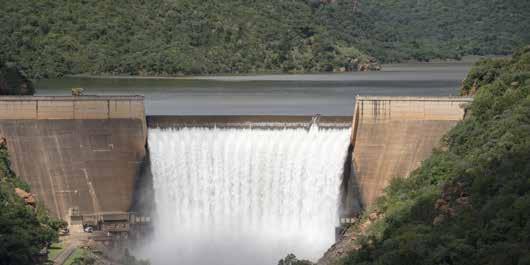
University’s Civil Engineering Department, former chairperson of the reservoir sedimentation committee of the International Commission on Large Dams (ICOLD), and a current member of the World Bank-Unesco Task Group on reservoir sedimentation management. ICOLD assessments suggest that several countries – almost a third of them in Africa – could therefore experience critical sedimentation volumes by 2050.
Management strategies
Several management strategies to combat and prevent siltation have been explored and implemented – including extensive catchment management strategies focusing on land-use practices and restoration, in an attempt to minimise soil erosion – effectively treating the problem at the source that often contributes the majority of sediments. Other management options include the construction of upstream ‘check-dams’ to aid in trapping sediments during flood events, by-passing schemes via tunnels or off-stream dams, as well as flushing or sluicing techniques. These strategies provide alternatives to the traditional approaches of simply raising dam walls or constructing completely new reservoirs, which are both often extremely expensive.
Locally, less emphasis should be placed on strategies in reservoirs that rely heavily on water, such as flushing and sluicing, and more on alternative measures. This is because South Africa is largely an arid environment, so most dams do not have the excess water
available to carry out these operations. There are also potential problems downstream because of the release of large volumes of muddy water that can inundate river beds and have drastic effects on downstream ecosystems if they are not properly planned.
Sediment research
Sediment research and the daily suspended sediment sampling of rivers in South Africa started in the 1920s. By the 1970s, with many new dams constructed, most of the river sampling programmes were stopped and replaced by reservoir surveys by the DWS, which are recorded in the so-called ‘Dam List’. These early sediment yield maps for South Africa were updated in 2010. Earlier this year, the WRC developed a shortlist of 20 dams believed to contain among the highest silt levels.
Some of the dams of concern include the Lake Arthur Dam on the Tarka River (52% silted), Darlington, Nqweba, Lubisi, Grassridge and Bospoort (all above 40%). In KwaZulu-Natal, the Hluhluwe Dam is estimated to be 25% silted up, while the Gariep Dam on the Orange River (South Africa’s largest dam) is nearly 20% silted up. Looking to the future, other feasible options to manage siltation should be pursued, such as sediment by-passing, which is not new in South Africa. Many dams were designed in KwaZulu-Natal – such as the Nagle, Henley and Shongweni dams – more than 70 years ago, with sediment bypass facilities. Experts have recommended that such facilities be incorporated in the proposed Smithfield
Dam in KwaZulu-Natal to also help limit further coastal erosion.
The NatSilt Programme is essential in aiding the decision-making behind which strategies to employ for current and future dams, and is “absolutely critical to the country’s water security”, as emphasised by Dhesigen Naidoo, CEO at the WRC. Jurgen Kogl, a ministerial advisor for the DWS, pointed out at the recent NatSilt virtual symposium, held in May 2021, that dealing with siltation was sometimes viewed as a grudge purchase – in a similar way to how consumers often viewed buying life insurance. However, because of the massive cost of building new dams, the problem of siltation has to be tackled swiftly and head on, in order to extend the lifespan and capacity of existing infrastructure to supply water to South Africa’s fast developing and growing population.
FOR MORE INFORMATION:
Visit: https://wrcnatsilt.org.za



Digital water management solution
Joyce Moganedi, sales manager: Power and Water at ABB Energy Industries Division, speaks to Water&Sanitation Africa about ABB’s automation and control solutions within the water and wastewater industry.
ABB’s digital, electrical and automation solutions can help upgrade South Africa’s ageing infrastructure. These solutions cover all types of water processes: desalination, water pump stations, industrial water treatment and wastewater treatment.
Moganedi believes that the local water sector is aware of the benefits of digitalisation, and that there has been some positive movement towards implementing these technologies, but there should be more pilot projects and adoption. “Technology has evolved, and the prices of smart devices have decreased. Ripping out all the existing hardware is probably not the best approach. Utilities need to start with a clear strategic plan to create a full ecosystem. This can start by dividing the water network into discrete zones and identifying what is needed to address the specific challenges in each. Effectively, it is best to start small by adding to existing technology. In this sense, smart sensors are the perfect starting point, as they can be placed on a motor, pump, bearings or gearing. They are easy to connect and use, without having to invest in new, expensive systems.”
The next step would be to use a PLC (programmable logic controller) solution or Scada (supervisory control and data acquisition) monitoring software that would receive information from connected sensors or input devices, process the data, and trigger outputs based on pre-programmed parameters. “The digital part is the top of the pyramid. The bottom of the pyramid is the plant assets and then a Scada or PLC solution; only afterwards can further digital solutions be implemented. Digitalisation can be implemented on a gradual basis,” says Moganedi.
Unlocking value
Moganedi believes that many municipalities and end users make the mistake of viewing an ABB solution as a commodity and do not consider the value behind the solution. “They seldom factor in the money saved by creating greater energy efficiencies or minimising leakages. They do not consider the value our solutions provide or the after-sales support. In order to overcome this obstacle, I have started to mention key performance indicators (KPIs) instead of features and benefits. For instance, I now
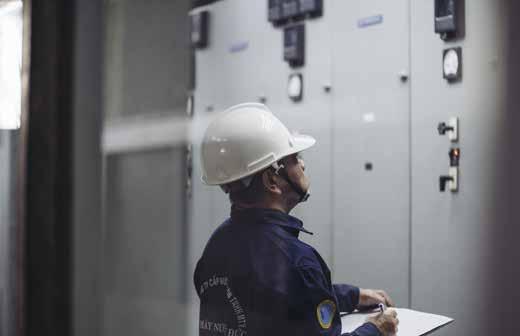

talk about how much our solutions can reduce non-revenue water or improve water quality.”
This can be achieved via ABB’s digital water management system that has user-friendly and KPI-oriented dashboards to provide an overview of the condition of a distribution network to operators, maintenance teams and managers. It offers real-time detection and localisation of water leakages, pipe bursts, faulty meters and equipment faults. This solution can help improve water supply quality, as well as drive operational and maintenance efficiency.
Global presence
ABB Energy Industries has a global presence and has worked with the water and wastewater industry in numerous countries. ABB contributed towards Botswana’s North-South Carrier water project by supplying a power and automation solution for a new water pipeline and pump station.
“Worldwide, water is far more than a mere commodity and is no longer taken for granted. If there’s no water, there’s no development. The availability of water and economic development are closely linked on numerous levels. There are decent jobs linked to water management in both the developed and developing world; moreover, access to safe drinking water and sanitation protects people from disease and allows them to attend school or work without disruption, leading to higher education and employment, which are foundational for growth. Problems like ageing infrastructure, urbanisation putting extra pressure on water supply, and limited water resources are experienced globally. While we have a local presence, we also have international experience in the water sector,” concludes Moganedi.
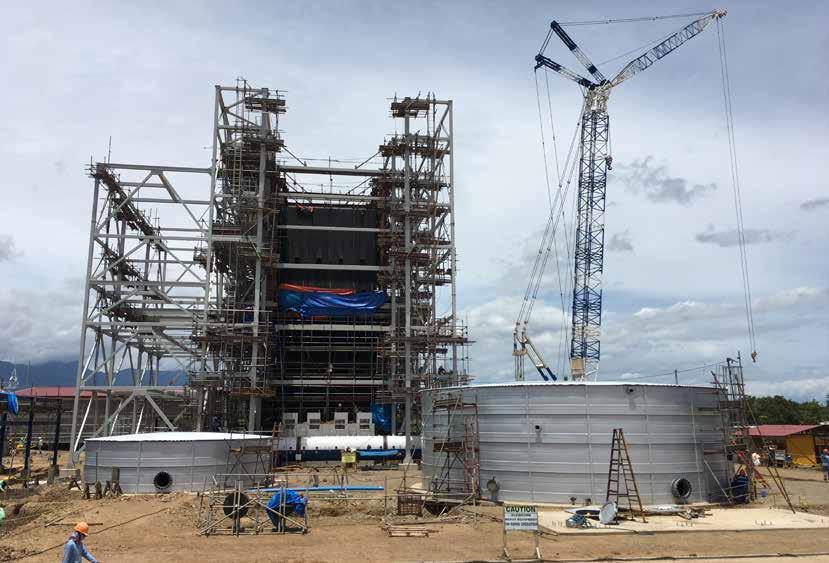
Water storage tank manufacturer expands range
What do St Helena, Madagascar, Mauritius and Seychelles have in common? Apart from being islands, they’re all home to Rainbow Tanks.
Quinton Coetzee, director of marketing and business operations at Rainbow Reservoirs, explains why:
“These islands do not manufacture water tanks. They have to import them. With air freight and sea freight, cargo is charged by volume. A single 10 000 ℓ plastic tank occupies a huge equivalent volume – you are basically paying to ship air. Islands therefore prefer Rainbow Tanks that can be flat-packed and then assembled onsite – the holding capacity of the modular Rainbow Tanks that can fit into a container is much greater, by orders of magnitude, than that of the plastic water tanks.”
Used in over 30 countries around the world, like Peru, the Philippines
and Panama, Rainbow Tanks can be transported to any place with minimal difficulty. “Concrete reservoirs require stone, cement and concrete mixers to be transported to site by road. Our tanks with
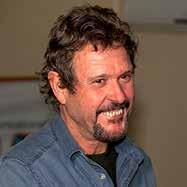
a capacity below 400 000 ℓ do not need a concrete slab – they are simply erected on levelled ground on a sand pad and can be transported by a 4x4 vehicle. Where other reservoirs may take months to build, it takes a few days to install our tanks,” says Coetzee.
Premium tanks for remote sites
Rainbow Reservoirs manufactures its tanks’ walls and roofs from premium aluzinc steel. The aluminium zinc coating is six times more anti-corrosive than a regular galvanised coating. All the tank’s fittings – like roof trusses, nuts, bolts and ladders – are galvanised for durability and long lifespan.
“Many tanks have to be installed remotely – in the middle of the Kalahari Desert, on top of a mountain or on a beach – and it’s a huge inconvenience if the nuts do not thread properly or wall panels do not fit perfectly. We therefore have modern, automated machinery that manufactures precision components to ensure everything fits 100% correctly,” adds Coetzee.
These premium-quality reservoirs are manufactured in varying sizes – from 5 000 ℓ capacity to over 4 Mℓ capacity –and can be fabricated in any requested

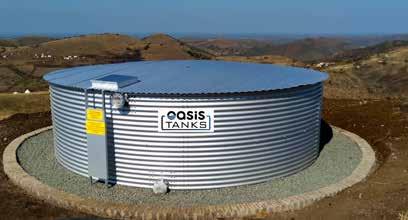
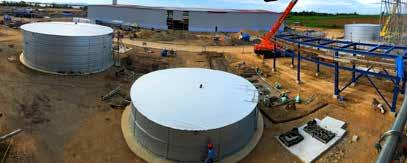
diameter and height. Included with each tank is a ladder, inspection hatch, in-/ outlet and overflow, while a scour drain, gutter system, level indicator or wind turbine ventilation fans are optional extras. They are also fitted with different tank liners suited to various applications.
The company supplies tanks to municipalities, townships, residential estates, agriculture, the food and beverage industry, the hospitality sector, and mines.
“With a new mine, tanks for potable water are usually installed before anything else, as only then can people move on-site to build infrastructure. Tanks are also essential for a mine’s processing needs,” explains Coetzee.
Rainbow Reservoirs is a specialist in firefighting and hydrant tanks. Accredited by the Automated Sprinkler Inspection
Oasis Tanks
2 3 4
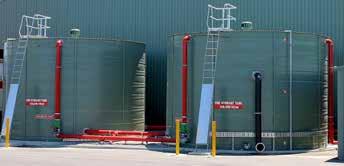
1 The construction of Rainbow Tanks in the Philippines
2 Oasis Tanks has stuck to the tried-and-tested corrugatediron profile that for decades has defined farm tanks on our agricultural landscape
3 Tanks can be manufactured in varying sizes – from 500 ℓ capacity to over 4 Mℓ capacity – and can be fabricated in any requested diameter and height
4 Accredited by the Automated Sprinkler Inspection Bureau, these firefighting tanks adhere to strict regulations for the proper design and installation of fire protection tanks
Bureau, they adhere to strict regulations for the proper design and installation of fire protection tanks.
However, not all markets require a topof-the-range Rainbow Tank; therefore, Rainbow Reservoirs has applied its expertise in the manufacture of sectional steel water tanks to create the new Oasis Tanks product.
While the Rainbow Tank range is used in some of the biggest shopping malls as high-tech firefighting tanks, sprinkler and fire hydrant tanks, Coetzee explains: “A farmer may not require a tank of those rigid specifications to water crops. Consequently, we have developed a range of cost-effective, agricultural tanks adapted to the landscape, our harsh climate and specifically to the needs of our farmers.”
Rainbow Reservoirs retained the traditional corrugated aesthetic of farm tanks and make use of modern technology. “Farmers are ever more conscious of water conservation and recycling. Furthermore, water used in micro-sprinkler systems must be free of impurities that may clog up irrigation systems. Our settling and filtration tanks are pivotal in this function.”
“Individuals and companies are starting to take ownership of their own water security by using tanks provided by Rainbow Reservoirs. We can no longer rely upon rainfall or local authorities for consistent or reliable water supply. Businesses are realising that they need a bulk water reserve for the continued running of their operations during municipal water outages or restrictions. It is imperative that we all do everything we can to save and conserve water,” he concludes.

Profitability and resource conservation can co-exist. WASA speaks to Chris Braybrooke, GM: Marketing, Veolia Services Southern Africa, about intervention and management strategies.
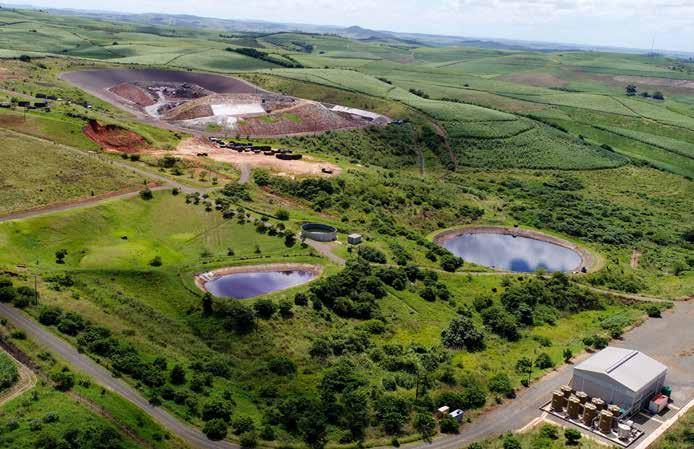
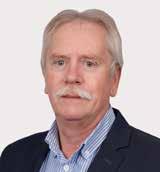
Why is water stewardship so important?
CB The impacts of climate change are all around us, especially when it comes to water quality and water scarcity. Unless all sectors of society take collective responsibility, we run the major risk of polluting the few resources we have left. That will in turn push up the cost of water purification treatment and compliance, with a resulting financial knock-on effect for industry, mines and their neighbouring municipalities. That’s why it’s critical that mines and industry take full responsibility for their water cycle – from abstraction to treatment and eventual discharge.
How does Veolia help mines and general industry remain compliant?
The cost of non-compliance is not an option, whether from an environmental, reputational or operational perspective.
Determining the true cost of water
Mining and industrial operations run 24/7 and they cannot afford to shut down even for a few days. Were this to happen due to a non-compliance issue, the repercussions could result in the withdrawal of investor support, punitive fines and even business closure.
Our focus at Veolia is multifaceted across our three core business areas, namely water, energy and waste. We work with our mining and industrial clients to shift these elements from a potential risk to a business opportunity.
In this respect, Veolia has more than 350 proprietary technologies that we can draw from to develop tailored solutions. That’s important because mining and industrial wastewater streams tend to require complex process techniques. Within the mix, there are also energy opportunities. Examples include biogas plants used to fuel boilers and/or as a heat source. Although essential, investment in water
and wastewater treatment plants is capital intensive, and the cost doesn’t contribute positively to the mine’s bottom line. However, not having adequate treatment facilities in place also means that mines cannot legally operate. So, it’s about finding the optimum financial and environmentally compliant balance.
What is Veolia’s SHEQ policy?
Across the board, Veolia has strict safety, health, environment and quality (SHEQ) systems in place. As a company, we have a zero-tolerance approach to noncompliance across all our operating sites. The Veolia Group is further governed by its Impact 2023 programme.
Impact 2023 aligns Veolia’s multifaceted performance model with the UN’s Sustainable Development Goals, against which all Veolia business units are measured in terms of agreed-on key performance indicators.
The five elements of the Impact 2023 wheel are environmental, commercial, economic and financial, human resources, and social performance.
It’s a two-way model, where we apply Impact 2023 to empower our employees to optimise client efficiencies, skills and profit margins.
What are the key steps to bringing down costs and improving efficiencies?
The ideal for any mining or industrial operation is to aim for zero liquid discharge (ZLD) and/or zero effluent discharge.
We start by providing a full risk assessment of the mining or industrial site. This entails a water cycle audit and technical study. Veolia refers to this exercise as determining the true cost of water.
Factors to consider within the process circuit include incoming raw water, process water, wastewater generated, plus the effect that seasonal rainfall patterns have for that region. Since mines and industry tend to be major water users, water scarcity is an operational risk factor.
Once this report has been completed, we then dissect, model and map out a mitigation strategy for the client. This could include changing process steps and/or introducing further Veolia technologies, like wastewater reuse. We also recommend pilot trials, followed by a phased approach.
The modern way is to build scalable, modular plants that reduce the footprint. Clients also prefer this approach, as it ties in with their carbon reduction strategies. Locally, our modular units are manufactured in Sebenza, Gauteng, either as skidmounted or containerised plants.
Is there a proven cost benefit in outsourcing operations and maintenance (O&M)? Globally, mines and industry have
recognised the benefits of outsourcing non-core operations like water purification and wastewater treatment. This is a field where Veolia has vast experience, working on hundreds of customer sites worldwide.
We’ve been able to pass on significant operational benefits, bring down energy consumption costs and, in many cases, turn a hazardous waste stream into a financially viable by-product.
We have a steadily growing client base in South Africa, ranging from food and beverage producers to automotive manufacturers and deep-level gold mines.
A prime example of a large-scale client is our O&M contract for South Africa’s largest steel producer. On this customer site, there are around 32 process areas that require some form of water or wastewater treatment. They have a ZED programme in place, which includes a highly successful water reduction strategy. All recovered and treated water is recycled back into the process engineering cycle.
Examples of Veolia innovations employed are HPD® evaporation and crystallisation technologies. Key benefits include the recovery of by-products from waste streams, and volume reduction and water recovery. The objective wherever possible is to manage and reduce waste generation on-site to reduce the cost of disposal.
Has Veolia secured any new O&M contracts recently?
We were recently awarded a major O&M contract for one of South Africa’s deep-level gold producers. This is an exciting and broad-ranging project. We’re treating water from depths of 4 000 m and producing potable water for the mining operation. We are also responsible for the optimisation of the mine’s cooling and ventilation plants. These tend to absorb large volumes of water and are essential for regulating
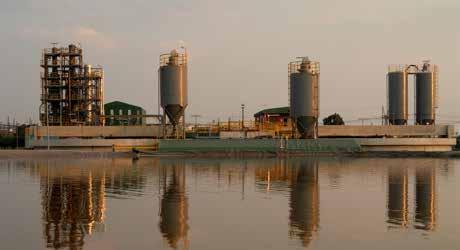
underground temperatures at workable levels for miners.
What is Veolia’s local strategy for its waste business?
An exciting development is the acquisition of Dolphin Coast Landfill Management (DCLM) in KwaZulu-Natal. This is a hazardous landfill that serves some 400 clients from diverse industries. We’ve invested in new technologies like HPD to maximise opportunities for saleable byproducts that include ammonium sulfate, which can be used as a fertiliser.
Does Veolia have solutions to combat acid mine drainage (AMD)?
AMD remains a huge problem. These are high-sulfate, low-pH waters that tend to be very corrosive. The volumes keep increasing and the environmental threat needs to be countered. Fortunately, there are effective interventions, and around 80% of the treatment process can be handled using membrane technologies.
The final process steps can successfully convert AMD sources into potable water. There are also solid waste beneficiation opportunities. The best example is gypsum, which is used in the manufacture of building materials like drywalling.
What’s Veolia’s track record to date for environmental efficiencies?
The fact that Veolia is around 168 years old speaks volumes. What started with a focus on water purification has subsequently evolved into an interrelated water, energy and waste business vital to human development and sustainable performance.
It’s our job to help clients mitigate their risks, optimise process and environmental efficiencies, and lower their water footprint.

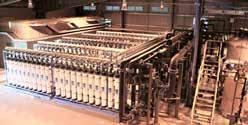
This year marks consulting engineering firm Knight Piésold’s 100th year of existence. The practice was started by a water engineer and now offers a broad range of expertise to assist with industrial effluent and mine water. Kirsten Kelly talks to a few members from the team.
Andrew Copeland (AC) Technical Director: Mining Division

Holistic approach to mine and industrial water management
What is one of the biggest components of mine water management?
AC Tailings can consume up to 70% of a mine’s total water consumption. Therefore, if a mine can dewater its tailings, it will drastically reduce its water losses and, hence, consumption. Minimising water storage and improving operations
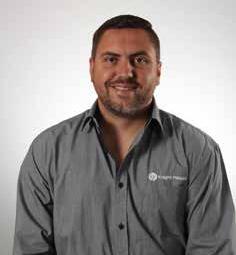
of the tailings dam can also decrease the mine’s water consumption. Furthermore, by changing the deposition method of tailings – from a spigoted system to a cyclone system – one can reduce water consumption by about 10%.
The design of tailings dams is important because that determines whether water can escape as surface

water or groundwater. Water released from a tailings facility is typically not clean; the level of contamination will depend on the type of mine and process used on the ore itself. There has been a drive in South Africa to protect groundwater by installing barrier systems into new tailings dams, as well as into any return water or pollution control
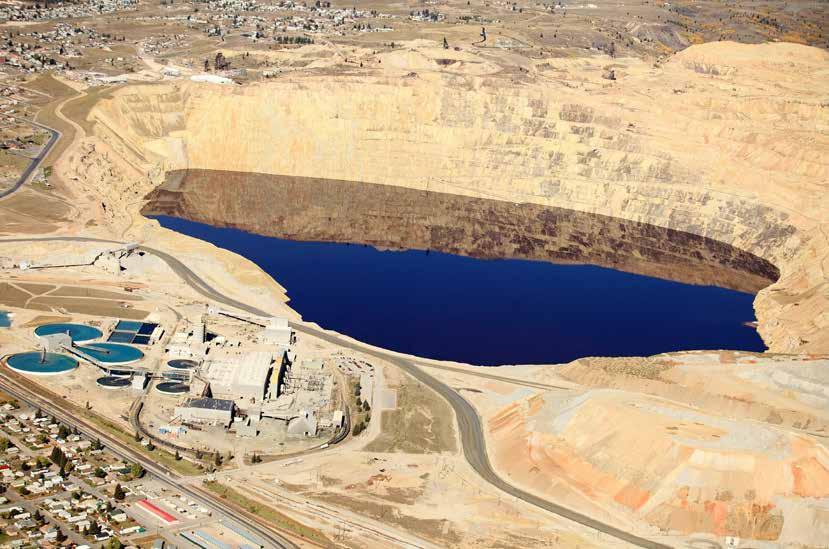
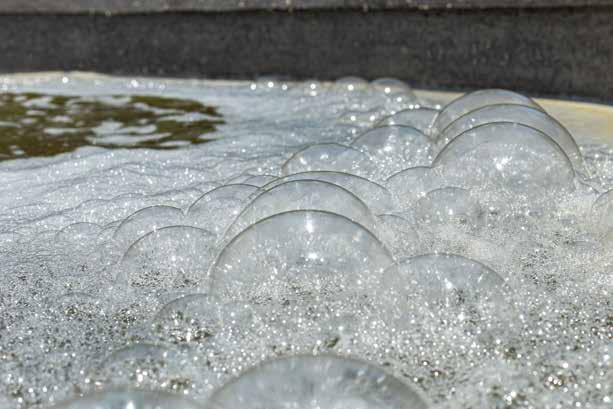
facilities. Return water dams must be sized sufficiently to handle excess stormwater and minimise surface water pollution.
What other water issues do mines need to consider?
LN Stormwater management will ensure that there is no contamination with dirty water.
Dirty water must be treated using technologies like reverse osmosis and ultrafiltration before it is released. Mines need potable water supply for their operations and employees. This can be difficult to obtain in rural areas without some purification process.
AC When treating water on a mine, one must consider the geochemistry of the ore body, as this will determine whether the water is acidic, or has a high dissolved solids or metal content. The geochemistry will establish pollution control requirements and methods used to manage mine water. Sometimes, a process plant will change its chemistry due to the addition of acid, lime and reagents like cyanide used in the plant.
What can mines do to make sure they use as little water as possible?
AC This would start with the mine design. A tailings dewatering system would have to be considered in the mine’s process plant. The cheapest way to dewater and transport tailings is the use of a standard or high-rate thickener, where the slurry would be pumped out to a tailings facility. There has been a trend towards dry disposal, which will produce slurry with a toothpaste consistency that still has to be pumped. With dry disposal, around 60% of water in the process plant will be recovered and 40% will be lost to the tailings facility. To achieve dry disposal, mines need to use a filtration-type system (vacuum filters, filter presses, disc filters).
But it must be noted that the dewatering and transport process becomes significantly more expensive as the moisture content decreases. The
cost of water and environmental impact have historically been far less than the dewatering process. However, due to a large number of tailings dam failures around the world, many mines are considering drier tailings disposal because the potential cost and consequences of a tailings dam failure outweigh the capital and operating costs that result in safer tailings facilities that use less water.
Is switching to a wastewater reuse strategy a viable option for mining and industrial processes?
LN All mines and factories need to treat water before it is released, and this is an expensive exercise. Therefore, instead of always using new water, many mines and factories try to reuse their water wherever possible.
Water treatment can be a complex process and requires constant water testing and specialised skills. For example, phosphates found in wastewater can affect some industrial processes, while it will not affect others. A lot of mines can use treated wastewater, but need to use better quality water in certain processes. If mines can use wastewater, they often find that they need bigger quantities than those available.
Every mine and factory is faced with its own unique challenges with regard to water security and creating zero discharge at a feasible cost.
AC In many cases, the process plant can reuse mine water that is either from underground or the tailings facility itself. Water from wastewater treatment plants can also be reused. There are even cases where sea water can be used in processing. This can be expensive if desalination is required.
How can a mine or factory reduce the cost of water treatment?
LN The more contaminant in the water, the greater the cost to treat before discharge or reuse. First, I would suggest stormwater be separated from all other water as far as possible. You have to avoid increasing the volume of contaminated water. The cost of


Groundwater & Fluid Levels
Serie 36XiW level sensor
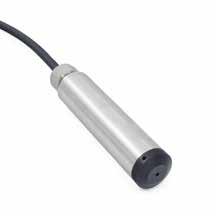
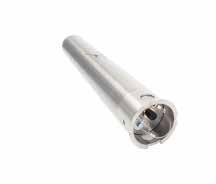
• Swiss precision: Accuracy 0,05%FS TEB*
• Internal datalogger for backup (ARC-1)
• NB-IoT, LoRa, 2G / 3G / 4G
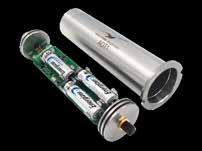
• Optionally: conductivity, other materials (Hastelloy of Titanium), ATEX
• KELLER Kolibri Cloud : no monthly paid subscription
* TEB = Total Error Band, thus the maximum possible error
2G 3G 4G

treatment is directly related to the type and volume of contaminants in the water.
AC The cost of treatment can also be impacted by how a mine deals with its waste material – waste rock or tailings. As soon as the waste rock or tailings have contact with water or oxygen, there is a potential for acid mine drainage (AMD) that is found in some coal and gold mines. Every time there is rain, there is potential for pollution. If mines can reduce the contact between water and acid generating waste, they can reduce the amount of dirty water produced and the cost of treating it.
How do you treat AMD?
AC If tailings are kept underwater, they cannot oxidise and convert to acid. However, this is not always practical and can be risky.
Acid-generating waste rock should be encapsulated with non-acid-generating waste rock. This creates a protective layer of non-reactive material around reactive material – minimising the contact the acid-generating rock has with water. This means that you have to manage your waste rock facility so that non-reactive material is readily available as cover material.
Lime can also be added to neutralise the acid, building up a buffer system that generates neutral instead of acidic run-off. This still needs to be treated prior to release.
LN The adage ‘prevention is better than cure’ applies here because AMD treatment can be a very expensive chemical process. It generates sludges that must be dealt with using processes like ultrafiltration and reverse osmosis. This is typically a hazardous waste requiring landfill containment.
What is the environmental process that a mine or factory goes through when obtaining a water-use licence (WUL)?
NN A WUL is needed to abstract water from a river or borehole or to build a dam. The process is handled by the Department of Water and Sanitation (DWS). It is a tedious process that requires proper engineering and environmental input.
Designs have to be done in accordance with legislation. All potential negative environmental impacts should be mitigated. The DWS must also establish if it is viable to grant a WUL in that catchment or water management area. The department evaluates the amount of available water and the amount that can be extracted.
A WUL is often amended if the volume of water extracted exceeds the volume of water
present in the groundwater or surface water resource. A WUL also requires a thorough public participation process with communities that utilise or depend on the water resource and may be negatively impacted.
When can a mine or a factory discharge water?
NN A WUL is also needed to discharge water. Here, the DWS will assess the quantity and quality of effluent discharged. If water is discharged into a stressed catchment, very specific water quality parameters will be added over and above the wastewater standards. There will be baseline monitoring of the industrial effluent and then there is biomonitoring to evaluate the health of the river systems.
There is a wide range of water quality guidelines that must be met, depending on the type of industry and processes used. For example, looking at the aquatic environment (rivers) and mines that discharge water into rivers, the Guidelines for Aquatic Ecosystem will be used as a guide. This is more stringent than drinking water guidelines because there are organisms in the river systems that are more sensitive to a human drinking that water.
Should standards and legislation be updated?
NN I believe that the quality standards should be updated taking the current environmental situation into account. I do not believe that it should be less easy to discharge water, but most of our catchments and rivers are in an altered state. It makes little sense to make a mine discharge pristine water that surpasses the quality of water received from our taps. This is why it is important to do baseline water quality monitoring for WULs so that recommendations can be made to the DWS with regard to the water quality that should be adhered to as a special condition. This will then supersede all other water quality guidelines.
What are the challenges experienced by the mining and industrial sector with regard to water?
AC The cost of water is rising and the availability of water is a concern, as is pollution.
LN The availability of quality water is of huge concern to the mining industry, because it influences productive and profitable mining, industrial processes, workers, and communities.

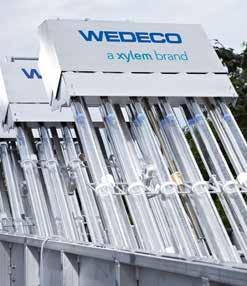

Trends and issues facing the water treatment industry
Members of water treatment company Watericon give their perspective on waste reuse and the discharge of wastewater.




What is the status quo with regard to mine water in South Africa?
BP There are a number of old, dilapidated gold mines in the Witwatersrand area where there are rising water levels in the mines and acid water has accumulated. This has started to decant into the Springs, Krugersdorp and central Germiston areas. The Witwatersrand holds the second largest amount of acid mine drainage (AMD) in the world.
The responsibility to deal with the AMD of these mines has fallen on the Department of Water and Sanitation. Neutralisation is used when treating a large volume of AMD and around 200 Mℓ of water is treated a day. If that water could be recovered, it would assist Rand Water with water supply.
In Mpumalanga, there is ash water with a high pH value. In the coal mine areas,
there are evaporation dams with crystal clear blue water that is toxic. Companies like Sasol and Eskom are extremely progressive in that they are recovering this water and reusing it. Desalination and evaporation technologies are used.
In Limpopo and the North West (the platinum belt), the treatment of their water is similar to the treatment of ash water in Mpumalanga.
Are mine water and industrial effluent being treated or dumped?
BP There is legislation to prevent the dumping of untreated water. Some municipalities have by-laws aimed at the discharge of industrial effluent.
The legislation and by-laws should be enforced by the Green Scorpions – a network of environmental compliance and enforcement officials from national, provincial and municipal government.
Watericon does get calls from companies that have had to pay fines and are asking for assistance in complying with legislation. But I do not believe that the implementation, monitoring and enforcement of the legislation and by-laws are as effective as they could be.
However, I do believe that large corporates are trying to be responsible and are treating their water to disposable limits.
Is there a cost benefit to outsourcing wastewater treatment operations and maintenance?
BP There is definitely a long-term benefit in using reputable companies that have a track record of water treatment. Watericon has been called to a few sites to fix water issues where a significant amount of money has
already been wasted on the wrong type of treatment or on a contractor that could not deliver results.
What advice would you give to companies that want to reduce the cost of water treatment?
BP With any industrial process, waste needs to be minimised from the source. Companies should try to reuse water in their industrial processes. I would also advise on scaling down large, complex systems.
CA It is important to generate value-adds from the process – e.g. the recovery of sludge products that could be sold as animal feed and generating biogas to run boilers that can reduce the cost of water treatment. Producing something that can be reused greatly reduces the cost of treatment. There is definitely a trend where a lot of our customers are focusing on reuse plants.
We were part of an interesting project with AEL Explosives. When manufacturing detonators, the company extrudes aluminium rods that go through the likes of a huge washing machine.
Watericon installed a small plant to assist with recovering wastewater and washwater back into the manufacturing process. This reduced the volume of wastewater, which was difficult to treat, being directed into the main effluent plant.
BP A similar project was Willowton Oil. This was for a solar plant where the panels needed to be cleaned and cooled with water. A Watericon treatment unit was installed to reduce the hardness of the water so that it could be reused.
What about water testing?
BP Ideally, a plant would have an on-site verification laboratory. The feed composition should not alter but, when designing a plant, we do add a safety factor. There may be some variances in the composition of raw materials.
With larger plants, especially when processing potable water, there would be split sampling between an on-site laboratory and an independent third-party laboratory in order to verify the accuracy of the plant performance.
If there is not a laboratory on-site, Watericon can provide a standard laboratory in a container, as well as portable kits for smaller plants.
CA Watericon Laboratories is part of the Watericon Group and is SANAS 17025 accredited. We do a lot of lab analysis of our customers’ effluent in our R&D laboratory. We trial different technologies on the effluent and run the analysis. We can also monitor changes in effluent over time.
The plants that we install are designed for a very specific process. Therefore, if any other type of effluent is added to the plant other than that which it was designed for, it may not work. It is very important to consider what effluent you want to treat right at the beginning of the design process.
What advice can you give, when investigating/using a water treatment plant?
CA Watericon Laboratories does a lot of upfront test work – this provides parameters around which a plant is designed. Where possible, we have even used a trial plant on-site that processes small volumes of effluent. This provides important data and a proof of concept for the client. It is key for successful effluent projects.
There is no silver bullet that can fix all your water treatment problems. I have personally seen many ‘white elephants’, where millions have been spent on a plant that is simply not fit for purpose. Every industry is different, and every factory generates different wastewater. Make sure that you have a plant that will work on a bench scale.
Are Watericon’s technologies scalable?
BP Most definitely. Watericon provides
water treatment solutions to individual homes as well as large mining projects. We have turnkey solutions for all water-related issues for households, mines, industries and municipalities.
Water treatment plants require a lot of capital. There must be many companies that need a plant but have no funds.
CA With Covid-19, capex is very tight. We can offer a BOOT (build, own, operate and transfer) contract. This is where Watericon will finance a project and install a plant, operate and maintain it, and then sell the water (at an agreed-upon amount and quality) back to a company over a 10-year (or longer) period. At the end of the contract, the plant is transferred to the company.
This is a trend that more customers are opting for. They typically want to focus on their core business and outsource all waterrelated issues.
What are some of the challenges and opportunities experienced in the water treatment space?
BP Waste is generated whenever water is treated, and waste recovery has become important. There is an increased focus on zero liquid discharge units or zero effluent discharge. There are an increased number of requests for brine treatment, sludge treatment and sludge beneficiation. Sludge is treated to compost, brine sludge has been used to create bricks, and biogas is a viable option for sewage treatment plants.
Watericon offers turnkey solutions for all water-related issues for households, mines, industries and municipalities
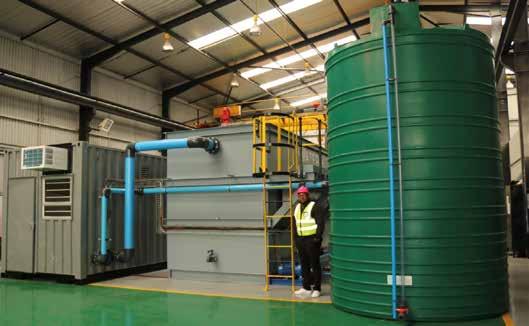
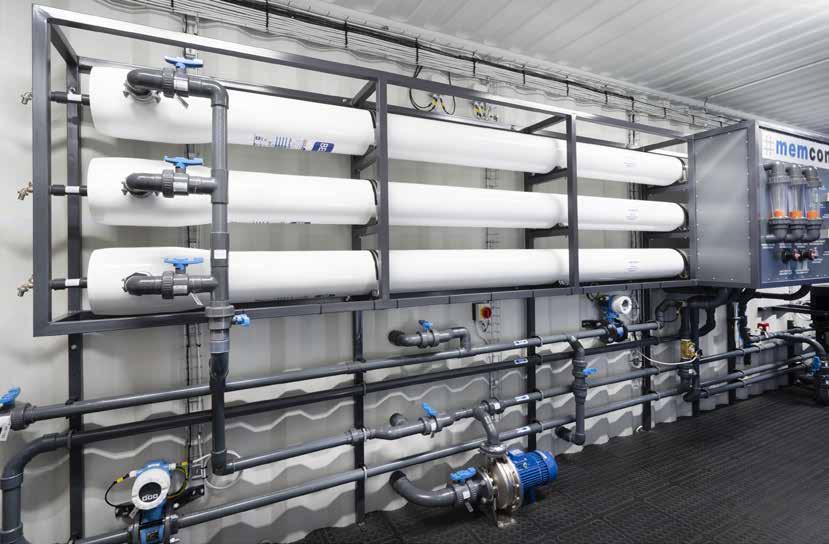
While focusing on production, effluent water treatment can easily become an expensive afterthought for companies. Gavin Mwanza – head: Engineering at Aquamat – talks to WASA about water treatment for various industries.
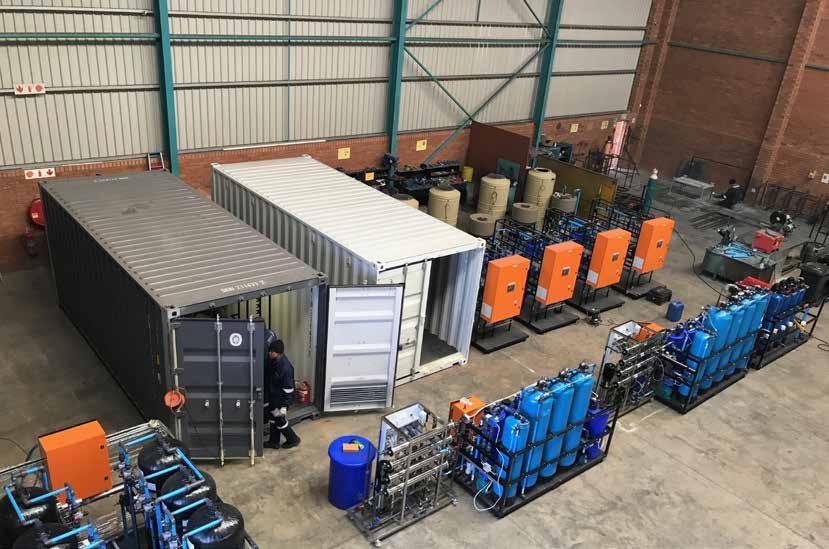
Industrial effluent should be central to all processes

What is a discharge licence?
GW Before discharging water into a sewerage network (for industries based in cities), industries need to apply for a discharge licence, which will specify the water quality standards the effluent must reach before it is discharged, as well as the maximum quantity that can be discharged. This licence is supposed to protect the wastewater treatment works (WWTW) – ensuring that it is not overloaded. If the quality of the discharged water is not up to standard, a company can be issued with a fine and a warning; if it does not rectify the problem, it may lose its discharge licence.
The conditions in each licence may vary with every city and every industry. A company producing steel will not have the same discharge licence as a company producing cheese. With a steel company, water contaminants may include electric conductivity and metals, whereas a cheese-making factory may include CODs, fats and oils. It would be pointless to monitor a company for a contaminant it does not produce.
What is the process once a company has approached Aquamat?
Companies approach us when they need to meet water quality requirements to discharge effluent. As discussed, effluent will differ according to the industry. Effluent even differs within the same industry.
Water analysis is therefore the starting point because a solution needs to be specifically designed according to the current water quality/water problems, as well as the standards to which the water must be treated. We also run trials. It is important to determine a worst-case scenario and design for that.
Based on the analysis and trials, we then develop a solution and propose a quote. That is part of the precontract agreement.
If the client approves the quote, Aquamat then commissions and installs the plant. From there, our services can continue with training and regular consultations regarding water compliance.
Effluent seldom remains consistent and its quality should, therefore, be consistently analysed and changes implemented to address any fluctuations. Some clients will have their own laboratories and quality systems in place, while others will contract Aquamat to do all the testing.
The reason the composition of effluent from a company may change could be attributable to the use of a different raw material supplier or the introduction of a new chemical into their process.
How do you reduce water treatment costs for companies?
We encourage water reuse. Yes, we help companies avoid municipal penalties by treating the water, but companies can save a lot more money if they reuse water. This is because industrial effluent is metered. The less effluent a company discharges, the less it pays – on both discharge rates and incoming water. Treated industrial effluent can be used for flushing toilets or cleaning factories, and can even be treated to potable standards.
The higher the required water quality standards, the higher the cost of water treatment. Drinking water and water to flush toilets should not come from the same water supply. If these sources can be separated, then it will be easier to use recycled water to flush toilets. This would mean that not all the wastewater would need to be treated to potable standards.
It is also important to remember that the nature of contaminants in water will dictate the type of treatment needed, which will dictate the cost.
What is the best approach when dealing with industrial effluent?
I will start with two don’ts:
• Do not move industrial effluent down the priority list while focusing on your core business. If you do not make industrial effluent a part of your production process, it becomes very expensive to treat. It will end up costing more owing to fines and potential lawsuits.
• Do not put up a plant and assume that industrial effluent will always be treated to the required water standards. It is an ongoing process that needs constant monitoring.
Then I would advise the following:
• Water treatment should not be a grudge purchase – it is about responsibility and keeping the environment safe for future generations.
• Valuable resources can be recovered from wastewater – e.g. recyclable oils, fertilisers and energy.
• Aim to discharge as little water as possible – always look to water reuse.
• People believe that they can only use water fit for human consumption. Less than 20% of water is used for drinking and cooking. Most water is used for flushing toilets, which does not require a potable supply.


Digital technologies for mine water management
There is limited research on the application of digital technologies at mine sites for treating and managing mine water
Christian Wolkersdorfer and Kagiso More – part of the South African Research Chair Initiative (SARChI) for mine water management at Tshwane University of Technology (TUT) – have identified theories and frameworks that can ‘smartly’ treat and manage mine water.
The mining industry is confronted with challenges such as low commodity prices, the increasing cost of electricity and production, and pressures from non-governmental organisations to provide fast and useful monitoring data. These issues are driving the mining sector to Industry 4.0, which leads to industrial transformation. However, the implementation of digital technologies drives an increase in skills demand ̶ resulting in high-quality job creation. As much as these technologies will not change basic mining principles, using electricity and mechanics, mine workers and their equipment will communicate through the internet of things (IoT).
Mine water treatment plants must start embracing the advantages that come with Industry 4.0. Digital technologies will enable ‘smooth’ reactions to changing
water quality or quantity conditions in the mine. For example, a mine will know whether a pump has stopped and why. This means that the pump, as well as its control systems and motor, will be connected to a network that will allow for an operator to know everything.
The SARChl Chair for mine water management at TUT will prove that upgrading mines to Industry 4.0 will result in the creation of new jobs that require a higher level of qualifications and better education. New skills will be needed to configure wireless devices and set up networks or knowledge on internet protocols.
These technological advancements will benefit the mining sector ̶ increasing the safety and security on the mine site, enabling the mines to reach higher production levels and optimising mine water management. With a data lake in the picture, communication between all the mine departments that deal with water becomes faster, easier and more reliable (Figure 1).

Current technologies in mine water treatment are controlled by the composition and volume of water entering the plant at


any given time (left-hand side of Figure 2). Often, this requires the plant to react instantly on volume or chemistry changes, as there is no foresighted interaction between monitoring data and operational parameters. Data includes precipitation, water inflow into the mine, technological changes within the mine, water analyses of the plant, and the outflow of the treated water.
TUT’s research will ensure that the mine’s technology will be improved, and all aspects needed for mine water management are considered adequately. These include sampling and monitoring data to develop intelligent mine water management (iMineWa) (right-hand side of Figure 2).
Internet of mine water
IoT is a system of sensors, electronics and software that allows for the overall communication and information exchange of all connected devices. It is all things that are tangible that could be reached by an internet address. Internet of mine water (IoMW) (Figure 3) is derived from the idea of IoT. IoMW refers to more than things. It also includes data and the results of data processing coming from common statistical procedures or the procedures involved to analyse big data.
hybrid intelligent systems, support vector machines (SVM), and k-nearest neighbours (kNN) technology. These numerical models and codes consist of numerous processing elements that receive input data and immediately produce an output. Using AI will ensure that data will be processed faster than currently. TUT’s SARChI Chair will transfer the growing popularity of AI and machine learning to assist mines in their future choices of mine water management.

Big data is extremely large amounts of data that can only be analysed computationally to reveal patterns and trends. These non-touchable objects are commonly referred to as digital objects and they can be referenced by persistent identifiers, such as digital object identifiers (DOI) or uniform resource names (URN).
AI systems
Artificial intelligence (AI) needs to be implemented for optimising mine water management. This will utilise smart data and machine learning to enhance mine water operations, as well as safety at the mine and workflow production.
Introducing AI in mine water management will be implemented as computational modelling driven by numerical algorithms that utilise expert systems and fuzzy concepts to support decisions. Machine learning models include, but are not limited to, deep neural networks (DNN), expert systems,




Measuring water levels in open-pit mining
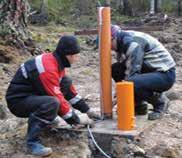
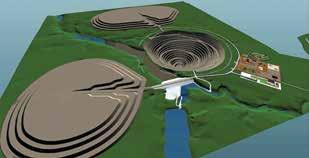
The Grib Mine, located in Russia’s Mezensky District in the Arkhangelsk Oblast, is one of the largest diamond deposits in the world. During winter, temperatures can reach -37°С.
The Arkhangelskgeolrazvedka exploration crew bores wells and monitors underground water levels and temperature. Keller (represented in South Africa by Instotech) has equipped the wells with water level monitoring systems. The use of automatic water level monitoring systems allows for savings on special-purpose vehicles as well as additional staff, who would conduct manual monitoring in remote and hard-toreach wells.
ABOVE LEFT Keller installing water level monitoring systems
ABOVE An illustration of the Grib Mine
ABOVE RIGHT As long as the monitoring net consists of cluster water wells, it is possible to use just one GSM-2 BOX module to register and transfer data from two to three wells placed at a distance of 5 m to 10 m in the same cluster
The water level and temperature are monitored within a 5 km radius of the deposit area. Between 2011 and 2014, a total of 81 wells (with depths ranging between 20 m and 270 m) were bored in order to monitor water levels. The wells are equipped with 81 Keller water level monitoring systems comprising PAA-36 X W hydrostatic pressure (level) and temperature probes, as well as 59 GSM-2\ GSM-2 BOX modules for automatic data registration and transfer by GSM.
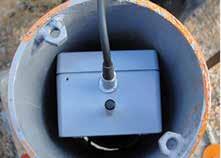
As long as the monitoring net consists of cluster water wells, it is possible to use just one GSM-2 BOX module to register and transfer data from two to three wells placed at a distance of 5 m to 10 m in the same cluster.
It enabled the mine to reduce the number of GSM-2 modules required for monitoring 81 water wells – from 81 to 59. Thus, the Grib Mine could buy 22 GSM-2 modules fewer than anticipated, creating an approximately 15% saving on monitoring equipment for the project. The battery of a GSM-2\GSM-2 BOX module is able to supply several level probes. The module, on the other hand, can register and transfer data once a day in a low-temperature environment with a low-level or unstable GSM signal for a few years. Interestingly, for the duration of the four-year exploitation period, Grib Mine did not find it necessary to change the equipment batteries.
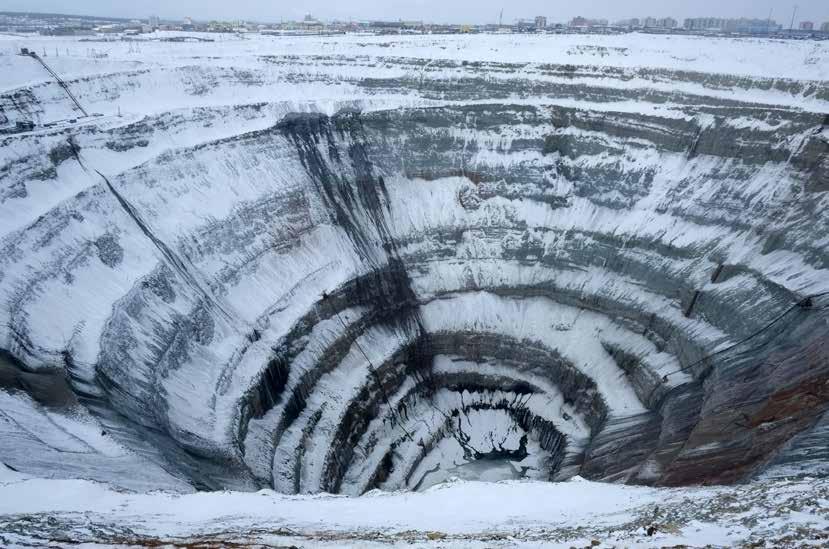
PAA-36 X W HYDROSTATIC PRESSURE AND TEMPERATURE
PROBES
These pressure transmitters are designed for level measurements where the highest accuracy is required. This series is based on the stable, piezoresistive transducer and microprocessor electronics with integrated 16 bit A/D converter. Temperature dependencies and non-linearities of the sensor are mathematically compensated.

Making use of acid mine water
Two companies that are incubated at The Innovation Hub’s Climate Innovation Centre South Africa treat water in local mining sites to provide clean drinking water, contributing to a cleaner environment.
BN Aqua Solutions takes acidic mine water from underground and treats the contaminated water to drinking stage by using a waste product that is locally available. The company has built a prototype model at the CSIR, where it has conducted various tests proving it can provide clean drinking water. What makes the project innovative is the use of waste material to treat the contaminated mine water. The result is not only clean drinking water, but also a reduction in waste material. BN Aqua Solutions reduces the environmental footprint currently caused by this unused metallurgical product. “This waste product is a by-product of a metallurgical process, and it has been stockpiled without use,” says Boitumelo Nkatlo, founder of BN Aqua Solutions.

AGRULINE
FITTINGS & PIPES
RESISTANT TO CRACKS
LONGER SERVICE LIFE
crack resistant PE 100-RC
HIGH ECONOMIC EFFICIENCY
sandbed-free installation
LASTING CONNECTIONS
better welding results
ONE STOP SHOPPING
complete PE 100-RC piping system
Professor Jannie Maree (left) with two of his PhD students
“We have found a cheaper solution to this problem and can also recover saleable minerals such as gypsum, magnetite and synthetic lime from the residual slag, which can help to offset the plant operating cost,” he adds.
ROC Water Technologies
“It is foreseen that mine water can be treated to recover not only drinking water but also pigment, aluminium hydroxide, calcium carbonate, sodium carbonate and elemental sulfur,” says Professor Jannie Maree, founder of ROC Water Technologies.
ROC Water Technologies has designed an ROC (reverse osmosis/cooling) process that can treat acid mine water to recover
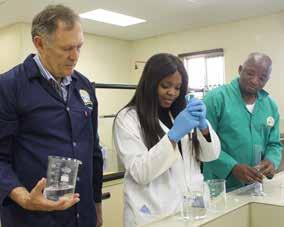
drinking water and saleable products in its various stages. Ferric hydroxide is recovered in the first stage of the ROC process, where sodium carbonate increases the pH to 3.5. The remaining steps of the ROC process make provision for removing the remaining metals in the water by raising the pH to 7.5, followed by the recovery of drinking water and a brine stream through reverse osmosis.
“These companies improve the standard of water from mining sites in South Africa and help us tackle problems such as water scarcity with real, tangible solutions,” adds Pieter Holl, CEO of The Innovation Hub.
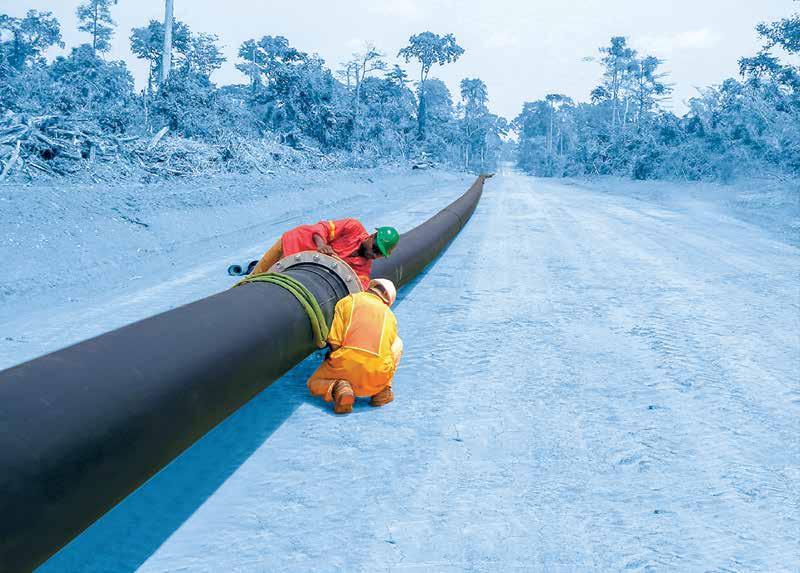










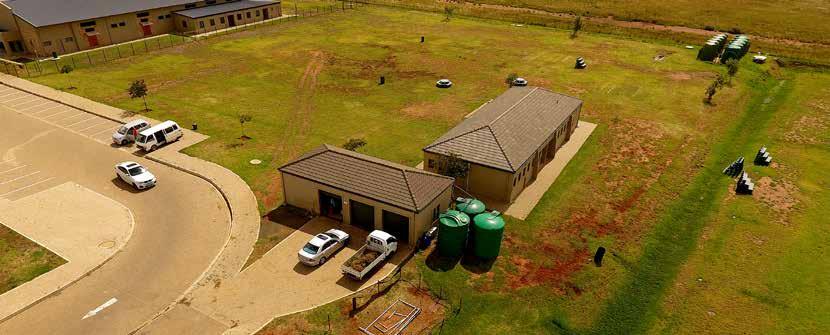
Wastewater treatment plants
that you cannot see, hear or smell
Celebrating over a decade in business, the owner and founder of Maskam Water – Gerhard Cronje – talks to Kirsten Kelly about the wastewater treatment industry.
How and why did Maskam Water begin?
GC Like most businesses, Maskam Water was born out of a need. I was asked to source an on-site wastewater treatment plant (WWTP) that must be installed underground, cannot be heard and is odourless. Furthermore, the effluent had to be used for irrigation purposes. I simply could not find anything locally that would meet the customer’s needs.
A few months later, the US Commerical Service contacted me. Zoeller from the USA was looking for a distributor for its pumps in the Western Cape. As this solution was unique, I imported a few of these pumps and then enquired about WWTPs. Zoeller supplied those too, and introduced me to its plants. I presented these to a local municipality as well as the Department of Water and Sanitation (DWS). After positive feedback, I imported and installed the first WWTP in August 2010.
Called the Clarus Fusion Series Treatment System, the WWTP is a drop-in system used in decentralised applications where the effluent quality needs to meet or exceed DWS standards.

After the first installation, we started to receive orders from referrals, and Maskam Water was born. To date, we have installed 298 plants in South Africa, Ghana, Nigeria, Kenya, the Democratic Republic of Congo, Namibia, Botswana, Mozambique, Mauritius, as well as the UAE and now the USA.
Are all of your WWTPs imported?
In 2016, Maskam Water started to manufacture some of the smaller plants locally to reduce shipping times and costs. In 2018, we began to manufacture some of the bigger models. This year, we have exported our first unit to the USA. While our plants are an American product, it has been found that it is far
more cost-effective to build these plants in South Africa and export them to the USA due to the exchange rate.
Why use the Clarus Fusion Series Treatment System over a septic tank? Traditionally, septic tanks are used in rural areas that are far from the metros. A septic tank will break down solids, but it cannot treat water. With septic tanks, there is a high probability that impurities will pollute groundwater. While the National Water Act (No. 36 of 1998) does not prevent septic tanks from being built, it does specify a level of water quality that
has to be reached before discharge, and a septic tank cannot reach that level of water quality. Furthermore, honey suckers are needed to remove wastewater from septic tanks and transport the wastewater to municipal WWTPs. This is costly and often inconvenient. Therefore, many municipalities no longer approve the installation of septic tanks.
Can these WWTPs be retrofitted?
You can retrofit with the Clarus Fusion Series Treatment System to any building and recover 100% of your wastewater. This is different from greywater systems, where there may be a problem as greywater often ties into sewer lines inside a building. In these cases, greywater cannot be separated from blackwater and the Fusion is the only answer to harvesting wastewater (grey- and blackwater) on-site.
What barriers have you experienced when selling your WWTPs?
In some municipalities, there are outdated by-laws stating that only the municipality can treat wastewater. Installing conservancy tanks or septic tanks does not require any applications but the installation of a WWTP requires a general authorisation from DWS, which can be a lengthy process.
Another barrier is a lack of skill. There are very few wastewater treatment specialists. Therefore, Maskam Water provides a free consulting service to engineers and architects. We create a solution around a customer’s requirements.
Additionally, there will always be resistance to something new. When
ADVANTAGES
Maskam Water opened in 2010, we were a new company with a new technology and a new international supplier. At the time, centralised WWTPs were mostly functional and many engineers adopted a ‘wait and see’ approach. Over the years, we have built a library of case studies with our successful installations and have witnessed an increased interest and uptake in our technologies.
What case study displays your WWTP’s unique features best?
We installed a WWTP for the Department of Environmental Affairs and Planning. This is a commercial building in Cape Town’s city centre, within walking distance of the Supreme Court and Parliament buildings. The WWTP is in the courtyard – demonstrating how our technology is odourless and cannot be seen or heard.
Roughly 50% of the building’s wastewater is treated for toilet flushing while the remainder is discharged into the municipal sewer line. Over a million litres of potable water is saved per year. This would be a great project to duplicate in other office buildings or shopping centres.
Water reuse is no-brainer – why is it not implemented at a bigger scale?
At the moment, it is not possible to treat wastewater at municipal works and then pump it back for reuse. There would need to be a new pipeline and pump stations.
OF THE CLARUS FUSION SERIES TREATMENT SYSTEM
• Designed for a rural and urban setup
• Consumes minimal power – 60 W per house or 336 W for a grouping of 20 houses
• Maintenance on the system is limited to one hour every six months
• Fully installed underground (out of sight)
• No noise pollution
• No odour
• Activated sludge system (follows the same treatment process as municipal plants)
• Removes nitrates and removes or reduces phosphates
• Factory built (requires only a plumber on-site)
• Modular – customised to required size
• Less wastewater is discharged to municipal WWTPs – putting less pressure on ageing infrastructure
• Wastewater is treated and can be reused for non-potable uses (like toilet flushing and irrigation), creating less dependence on municipalities and reducing the use of potable water
• Treating wastewater saves money, as less water is purchased by the municipality
It is possible to treat effluent to potable standards and pump it back to the potable network. However, reverse osmosis is used to treat water to potable standards and the process creates 30% of highly concentrated brine that cannot be legally discharged. Reverse osmosis is also very expensive (between R25 and R50 per kℓ). Furthermore, most centralised WWTPs are not built for growing populations in municipalities, so there will come a point when the entire network will have to be built to cater for the growing demand.
Decentralised plants like Maskam Water’s Clarus Fusion Series Treatment System can be used to reduce the demand placed on centralised WWTPs and prolong the life of the entire network. The future of wastewater treatment lies in decentralised systems, like the Clarus Fusion.
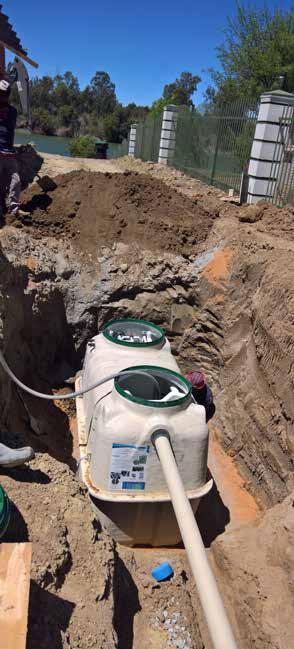
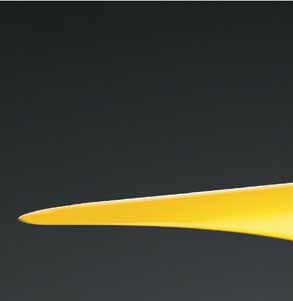
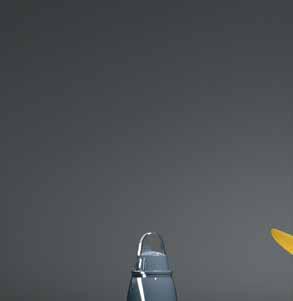
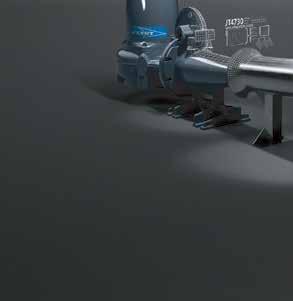
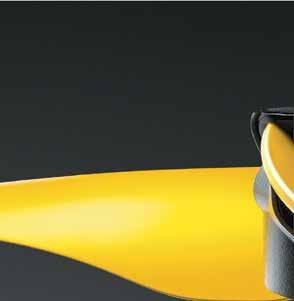
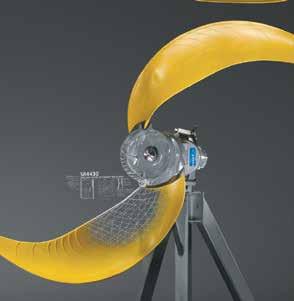



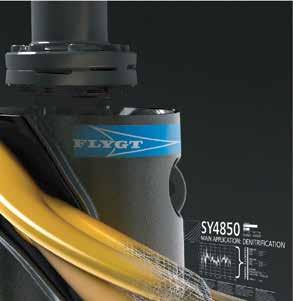
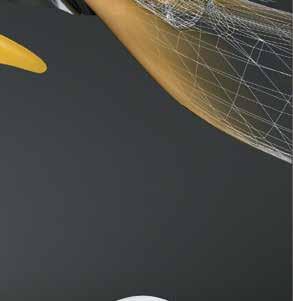





Rural sanitation and wastewater management vital for South Africa
Across the world, over two billion people lack access to basic sanitation, and at least a quarter of those practice open defecation. This problem is very acutely a rural one: according to Unesco, 91% of open defecation and 72% of people without basic sanitation are in rural areas. By Chetan Mistry, strategy and marketing manager for Xylem Africa
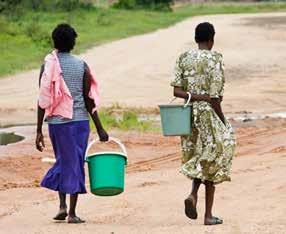
A2020 paper from Walter Sisulu University notes the connection between rural sanitation and overall social progress in a country. Rural and urban areas are interlinked. Here are some examples of how better rural sanitation and wastewater management could have a positive impact on the entire country.
It can address the past
South Africa’s colonial past has left a lasting impact on rural development. The majority of water and sanitation infrastructure reaches a minority of people outside urban centres. South Africa’s water supply and sanitation policy notes that water and sanitation issues are linked to housing, migration, land, social progress and national development. Addressing rural water and sanitation challenges is a potent way to exorcise the ghosts of historic segregation.
It makes women and children safer Women, children and the elderly dominate rural populations. Many rural communities draw water from undeveloped local sources, creating ample opportunities for crime and intercommunity conflict.
Collecting water is also a tremendous time burden, reducing a community’s effectiveness. Addressing rural water issues is a direct win for women and children, making them safer and more productive.
It saves energy
A lack of clean water forces rural communities to use a lot of electricity to boil water or source local wood, leading to more environmental problems such as erosion. Several studies show that the availability of developed water and sanitation sources, such as dams and wastewater treatment facilities, impacts the local usage of energy and natural resources in positive ways.
It's critical for education
South Africa suffers from a scourge of pit toilets – by the last count, over 3 000 schools still have pit toilets. They are often filthy, smelly and unsafe for human use. Pit toilets are a problem in most underdeveloped communities, and headlines of children drowning in them are unfortunately not uncommon – nor are stories of people being attacked in these remote and unattractive sites. Students who feel unsafe and uncomfortable do not learn well. Solving such rural challenges will be a big win for education.
It improves tourism
Many rural communities congregate around natural and undeveloped water resources. In their desperation to use those resources, which are often polluted by human activities, they engage in activities that devastate natural habitats that attract tourism. The practice of open defecation is also a deterrent for tourism activities. Yet if a community is equipped to access

safe and clean water services, they also have reasons to protect the local environment and promote tourism activities.
It eases healthcare burdens
The Covid-19 pandemic brought the fact that underdeveloped and rural communities do not have enough access to water for sanitation purposes into focus. Many share communal taps, creating spaces for disease to spread. In situations where wastewater management is lacking, contaminated water can pool to foster waterborne diseases such as cholera. Pit toilets also contaminate the surrounding soil. If we can resolve rural water issues, it would take a tremendous burden off healthcare systems.
It helps secure water in South Africa
South Africa is a water-scarce country. There is a virtuous circle between good water access, wastewater management, and how much a community will care about those resources. If we help rural communities access water safely, we will ultimately reduce the burden on local water supplies.
According to the Environmental Performance Index, South Africa ranks 133 out of 180 for water and sanitation. This gap indicates a lot of potential we can exploit to make our country more inclusive and equal.
We may face many challenges, but let us not think those are for urban dwellers and that the rural areas will inevitably follow the lead of cities. It works both ways: raise the tide for rural areas, and we will see everyone benefit. Even just addressing rural water, wastewater management and sanitation can spark a positive movement for all South Africans.
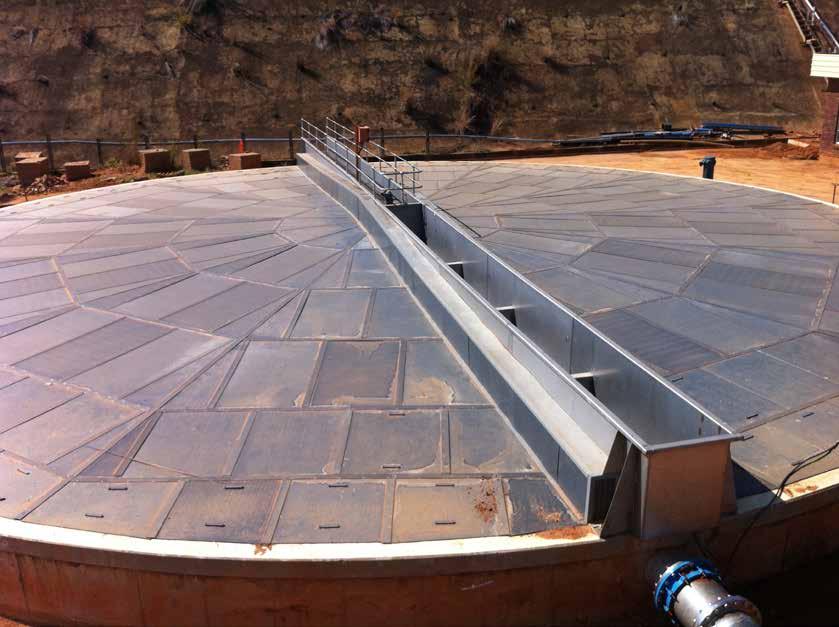
More to odour control than supplying equipment
Established in 1996, OdorCure typically partners with contractors, consulting engineers and municipalities when dealing with odour control issues in wastewater treatment facilities. Each of these role players has a different approach and interest when dealing with odour control.
With over two decades of experience, OdorCure has the technologies and know-how to meet the needs of these different parties. The odour control business is more complicated than simply delivering a piece of equipment. There is a technical aspect, as well as a contract and project management side to the business. It is also important to understand the operational environment that requires odour control,” says Hennie Smal, project manager at OdorCure.
Main contractor
For a main contractor, the pricing of odour control is very important because cost
weighs most in a tender award process. It is also important for the subcontractor providing odour control equipment, first, to supply fit-for-purpose equipment and, second, to install it properly and commission it to work correctly.
“If we are appointed by a main contractor to work as a subcontractor, it is important to understand not only the technical specifications but also the other contractual obligations and management process. Often, detailed drawings and documentation may have to be submitted and strenuous safety rules and regulations followed. It is important for the subcontactor to understand and be able to function in this environment with minimum fuss for the main contractor.

“Incorrect pricing, or not understanding contract requirements, has caused many a subcontractor to lose a lot of money and may even result in them not being able to perform. They may then be in breach of contract. This
can be a nightmare for the employer, main contractor and consultants alike,” adds Smal.
Consulting engineers
A municipality may approach consulting engineers with an odour problem. The consulting engineers will then investigate the problem and recommend possible solutions. Once a decision on the best option is reached, the consulting engineers will write a tender specification that will form part of a formal tender document.
Smal explains that, with a tender specification, an odour control company has to understand what is technically required. “Sometimes, a company will offer a particular technology without truly understanding the complexity of the application.
“The first mistake that companies make is that they misinterpret the contract specifications. The second mistake is that they underestimate the process that needs to be followed to install odour control equipment.”
A large amount of information may have to be submitted, and this could include detailed technical papers, brochures, papers and drawings (electrical, mechanical and civil drawings). All this information is assessed by the consultants who will have many questions. These questions must be answered satisfactorily and revisions to designs may have to be submitted.
“This can be a time-consuming process, and there are time constraints under a contract. Your designs can take months to approve. If your equipment is imported, there can be delivery delays. It is very easy to get lost in that process and to be

late – causing problems for everyone,” explains Smal.
Typically, civil contracts have a supply component, while mechanical contracts also include design. The design aspect of a contract adds a lot more responsibility for the mechanical contractor because performance specifications must be met.
Smal maintains that OdorCure has good relationships with all the consulting engineers in the wastewater treatment field. “Odour control is not something that consulting engineers deal with on a regular basis, so a knowledgeable odour control contractor can reduce risk for all parties involved.”
Municipalities
Municipalities typically want an odour to be eliminated. “We cannot offer a solution until we have a comprehensive understanding of the nature of the odour,” explains Smal.
Therefore, OdorCure offers scoping exercises whereby the type and concentration of gases present are determined. From there, the company can determine the solution used to reduce
the gases to the required level.
“Sometimes, a municipality will not have capital budget available, but can allocate operating costs. There may be a need for equipment that takes up minimal space or requires little maintenance. OdorCure offers a wide spectrum of options, including chemical, biological, electrochemical, thermal and physical solutions,” explains Smal.
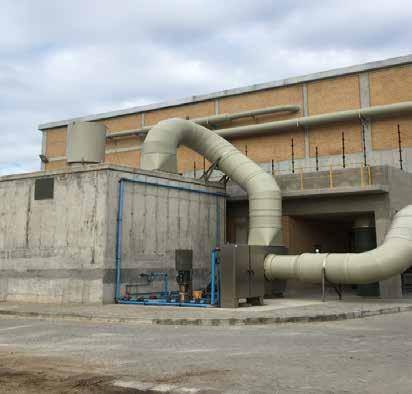
OdorCure offers a turnkey service, as well as maintenance. “Some treatment works do not have the expertise to maintain the equipment. We either maintain the equipment ourselves or try to keep the systems as simple as possible,” adds Smal.
Off-site monitoring is also used to evaluate pressure, flows and the

levels of chemicals at a site to improve the on-site capabilities of a wastewater treatment works.
Odour control contract
According to Johan de Bruyn, managing director at OdorCure, a successful odour control project requires fulfilment of three conditions:
1) Isolate the source – gases have to be captured; odour sources have to be enclosed.
2) Conveyance of the gases – the gases then have to be conveyed to a treatment system.
3) Treatment – the treatment technology must be capable of removing odours to below detection concentrations.
“It is important to offer a turnkey solution because using different contractors for the various aspects can be complex and increases risk,” explains De Bruyn.
In order to ensure quicker delivery times at a more affordable rate, OdorCure manufactures many components of odour control equipment in South Africa.
OdorCure offers a range of odour control technologies and has access to all the leading suppliers in the field.
“We are not tied to a single supplier and technology. We will always propose the best-fit technology that is suited to a particular client’s requirements,” he says.

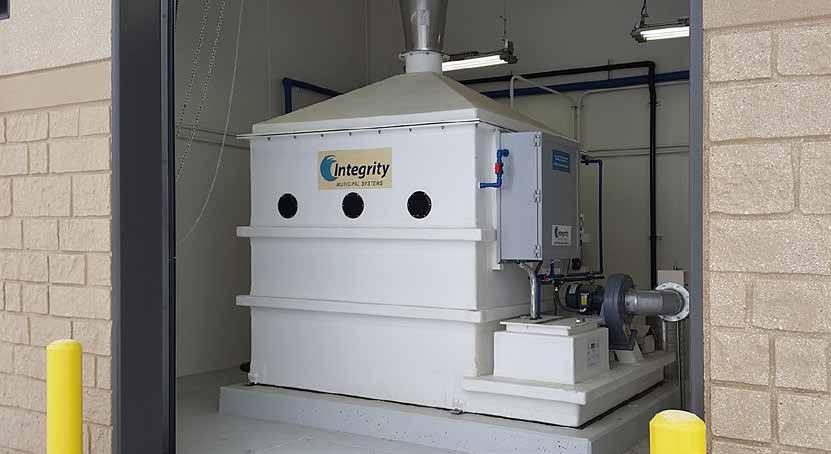
A biological odour control system – I-Box® 7010 –was successfully implemented at the Reeston Wastewater Treatment Works (WWTW).
No odour at Reeston Wastewater Treatment Works
The Reeston WWTW in East London was upgraded to increase its capacity to 12.5 Mℓ/day. The expansion was undertaken in response to population growth that had overloaded East London’s treatment system. As the site was close to a residential area, the project required an odour control system to ensure no odours escaped the plant.
Integrity Municipal Systems (IMS) was appointed to fulfil the odour control requirement of this project. IMS has developed a line of standardised, preengineered, factory-assembled odour control systems for treating odours at sewage pump stations and WWTWs.
How it works
The I-Box® 7010 is an IMS product that uses a two-stage biological system. The first stage removes hydrogen sulfide (H2S) by employing inert, inorganic media widely used for biological treatment. The second phase is an adsorption phase to polish residual H2S and organic odours from the airstream utilising carbon-based media.
Airflow capacity of the system was designed at 2 880 m3/h, with average inlet H2S concentration of 50 ppm and peak concentration of 100 ppm. The system
provides 99% H2S removal efficiency, with an estimated life of 10 years for the biological media.
A media irrigation system is incorporated into the biological system to provide the first-stage media with adequate moisture. The irrigation process is controlled by a programmed timing sequence that actuates a solenoid water valve located on the water supply piping. Frequency, duration and start times are adjustable. Stage 1 is intermittently irrigated by either potable water or treated plant effluent water at 200 kPa (provided residual chlorine concentration is less than 5 ppm). The water is sprayed over the top of the media while air is pushed counter-current up through the media. As the air passes over the moist media, H2S and other compounds dissolve into the water film on the surface of the media. The bacteria residing in the water film oxidise these compounds to release energy for sustenance and growth.
The water that trickles down through the media rinses away the acidic by-products of the biological reaction. Nutrients, commercially available fertilisers, are also trickled over the media to enhance and sustain the biological activity. The nutrients, housed in a tank, are dosed into the system by a nutrient pump.
The I-Box® system is factory assembled and tested for reliable, plug-and-play installation as a packaged system
Water and acidic sulfate by-products washed from the media leave the system through the drain piping at the bottom of the vessel and are returned to the wastewater stream.
The I-Box® 7010 biological system was installed at the inlet works section of the Reeston WWTW, as these areas are highly prone to H2S generation due to the turbulence created by degritters, screens and other equipment.
The system was successfully commissioned and now provides the required removal efficiency and protects local plant personnel and nearby residents from unpleasant odours.
Ultra V Solutions is the local agent for all IMS products. For more information, visit https://ultravsolutions.com

Complying with water quality limits set out in water-use licences (WULs) is imperative for mines, industrial organisations and other authorised South African water users. However, there are good reasons for taking a broad view when considering the option of treating water.
By Xanthe Adams, principal engineer, SRK Consulting
The environmental impacts of water treatment
Among the responsibilities of public sector water regulators is the maintenance of water resource quality in rivers, streams and other natural water bodies. WUL holders must generally comply with quality limits set for water discharged
into natural water courses. These limits are specified within the terms of a WUL.
Stricter limits and other water treatment triggers
Many users, both mining and industrial, may now be faced with

the need to meet more onerous water quality obligations. For example, if a new ecological reserve, including resource quality objectives is published, this might affect the quality limit specified in the WUL. The resource quality objectives are a set of limits and requirements published by government for rivers and their tributaries. It provides pollutant concentrations that should not be exceeded in that river system, to protect both aquatic ecosystems and people.
Some WULs state that once the ecological reserve is published, any resource quality objectives (limits) will apply in place of the original WUL limits. In many cases, that means there are far more stringent water quality limits for those water
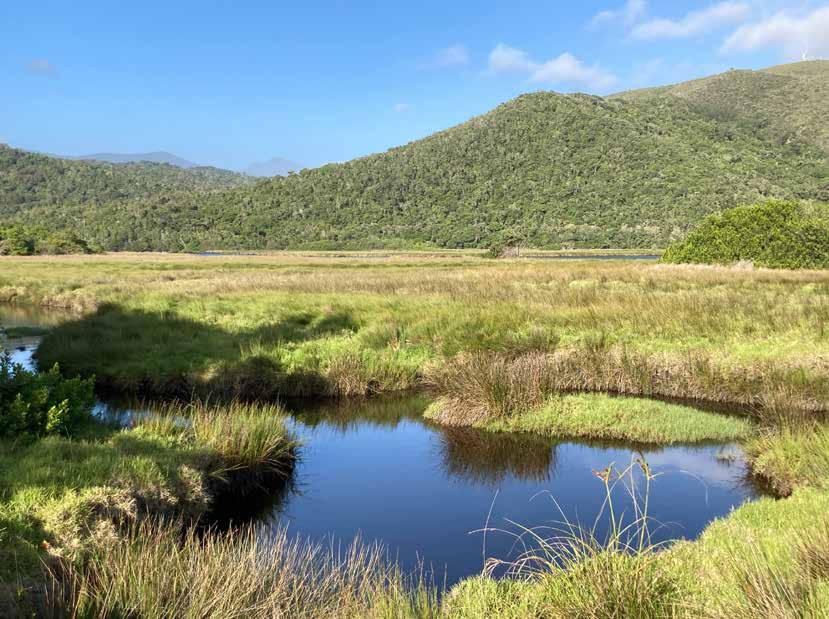
Water treatment options need to be assessed in terms of their full range of environmental impacts
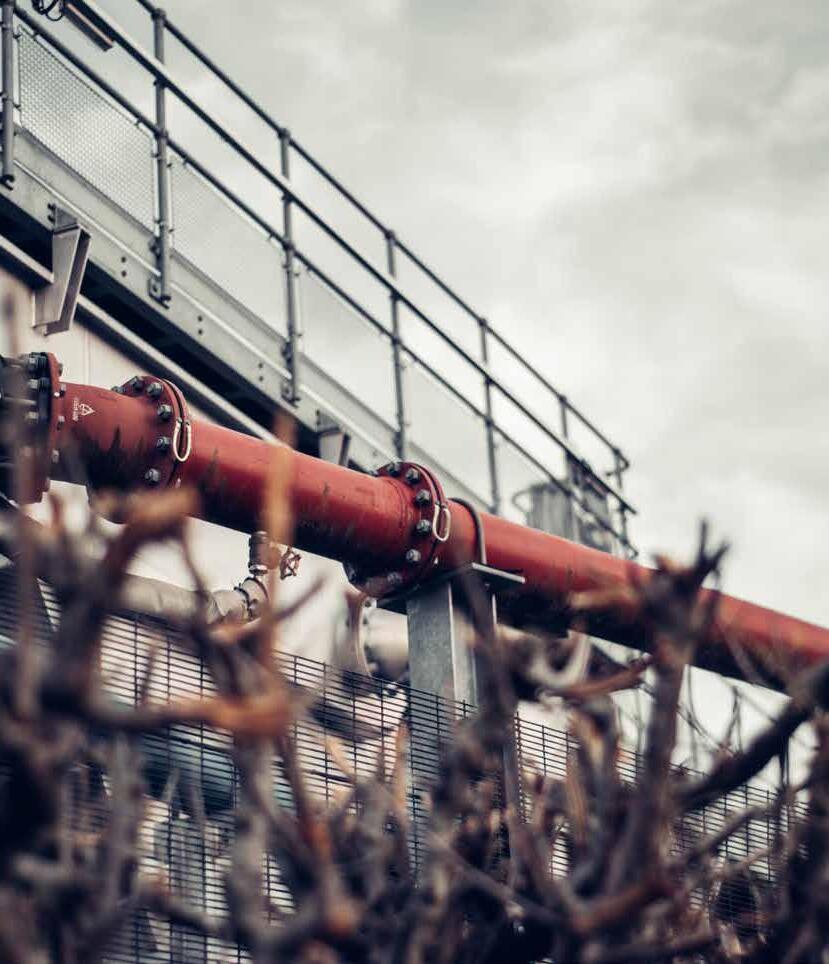
users. Other licences implicitly require consideration of the ecological reserve – by stating that users need to assess impacts in terms of the ecological reserve. Organisations should read their WULs carefully and consider the implications if such clauses are included.
Even where the ecological reserve does not apply, the question of how to meet quality limits might be new territory for users as they navigate stricter enforcement by authorities. Others might be grappling with previously overlooked discharges such as a polluted groundwater plume that seeps into a wetland. Mines nearing closure also face increased water quality obligations as they cease dewatering – and inundated open pits begin decanting to rivers.
Whether a company is looking to meet stricter limits or improve the quality of its discharge, one of the first decisions it will need to make is usually related to possible treatment options for the water it discharges. This is where a broader approach is valuable, because few water treatment options are completely free of environmental impact.
The trouble with treatment
Treatment processes will successfully generate cleaner water, but most also produce by-products or side effects that pose their own potential risks to the environment and community.
Reverse osmosis (RO), for example, is well accepted, not only for seawater desalination, but also for the removal of salts and metals that are common pollutants in mining and industrial discharge waters. However, the RO process emits carbon and produces brine. While there are defined processes for capturing and disposing of the residual brine, it is still a process that needs to be competently managed or it can become risky – and it nearly always has environmental impacts.
Many people understand that most treatment processes create waste; but the practical reality is difficult to appreciate until one calculates that, as in one real-world example, 27 trucks would be required each day to transport the brine to a hazardous waste facility. For such large volumes, transporting off-site would be unlikely but that does not lessen the waste burden. Even if brine is concentrated via crystallisation, the process will emit carbon and still produce a waste, albeit in lower volumes. On-site disposal facilities for brine, or other waste products, are another option –especially for remote mines – but these present their own problems. The waste is stored permanently, thus sterilising a piece of land and presenting an ongoing risk of leakage, especially as the facility ages.
When truly considering treatment, the key question quickly becomes whether the risk and impacts outweigh the benefits, and each case needs to be carefully assessed on its merits.
Alternatives to treatment
An early mentor once told me, to my great disappointment as a budding treatment engineer, “The first rule of water treatment is to avoid water treatment.” A kernel of truth exists in that statement.
Given the downsides of many water treatment options, companies should make sure that all other – less problematic – solutions are in place before turning to treatment. These alternatives might include additional source controls, such as further stormwater controls, which would prevent on-site water from becoming contaminated in the first place. Passive
treatments, such as artificial wetlands, with non-toxic waste products, such as nitrogen gas, can also be considered.
Amending WULs
If treatment is the only solution, then its unintended impacts need to be recognised. These impacts could even form the basis for an amendment to the water quality limits contained in a WUL – if the risk of the by-products to the environment, even with appropriate management in place, outweighs the risk of the untreated water or partially treated water being discharged to the natural water resource and downstream users.
To be clear, the aim of considering these broader aspects is not to reduce water quality limits by avoiding treatment through WUL amendments, but rather to ensure that any proposed solution is optimal to the environment and society. This is very much in keeping with the Department of Water and Sanitation’s own recent improvements to its water-use licence application (WULA) process.
To weigh up the impacts of treatment versus partial or no treatment, an options analysis is typically undertaken. Such an analysis should incorporate non-water impacts such as carbon emissions, waste disposal and site-specific quality limits.
Considering the options
Options analyses, while sounding relatively simple, are rather more of an iterative process than most water users expect. In fact, a good options analysis should raise difficult questions because that is the reality of minimising the impacts. Those difficult questions are usually around trade-offs between different types of environmental impacts. For example, is it better to prevent ongoing mild ecological damage in a river where metals-contaminated groundwater is surfacing or is it better treat the impacted water and deal with the risk of: first, very concentrated waste from the treatment process spilling into that same river; second, carbon emissions that might later affect the river via climate change; and third, the instalment of a
permanent disposal facility that damages terrestrial ecology?
Options analyses do not necessarily lead to treatment being discarded and a WUL amendment application. Some confirm treatment as the optimal solution and others lead to a combination of traditional treatment, passive treatment (such as wetlands), and a WUL amendment application to request the easing of water quality limits. There is a great deal of learning along the way in an options analysis, and investigations frequently expose not only unexpected costs and complications, but also other opportunities – some of them perhaps potentially innovative.
For example, a site-catchment-specific reserve – based on specialist scientific input by an aquatic ecologist – could be sought. Site-specific reserves can sometimes be more lenient than the ecological reserve if site conditions differ significantly from the broader catchment. If so, the site-specific reserve can form the basis of a WUL amendment application and decrease treatment obligations.
Experimental treatments are frequently investigated in options analyses, some with the potential to provide useable or inert waste products. Understandably, there may be resistance by authorities or companies themselves, as the real results usually take some time to be proven. However, technological advancement remains an imperative in the quest for environmental sustainability. This requires a commitment by all stakeholders to encourage scientific endeavour, which is based on sound principles and research.
To treat or not to treat
In short, a good strategy for WUL holders considering treatment is, first, to understand fully the regulatory limits that apply in their WUL. If complying with limits through treatment will generate significant impacts, then water users should invest in a broader study to answer the question of whether or not to treat. The answer may be something in-between, but if the study is rigorous, it will result in a net positive for the environment.
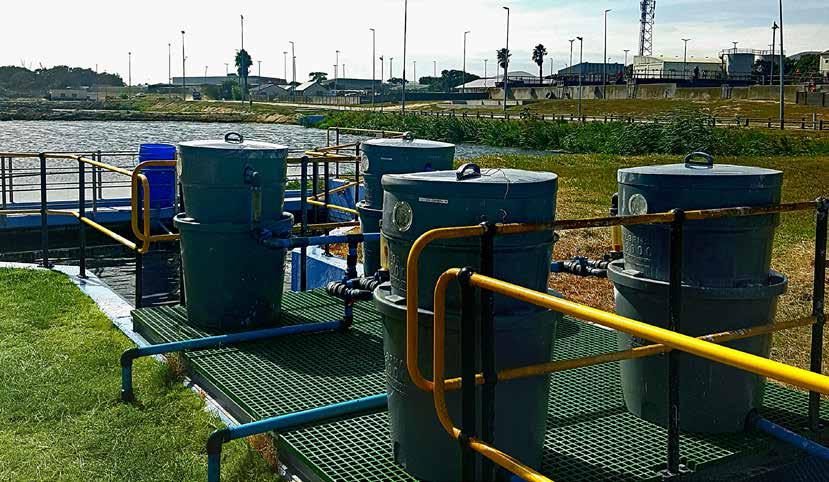
Costing end-point disinfection in water treatment plants
Budgets are tightening, and the responsibility to account fully for all input cost variables in water treatment systems is more important than ever. End-point disinfection offers a useful case study.
For example: everybody knows that bleach is cheap and chlorine gas is cheaper.
But is it really? There is a long-held assumption that the cost of a chlorination programme can be determined by comparing the relative cost of the chemical (R/kg), but recent extensive studies have invalidated this
perspective,” explains Peter Buchan, CEO of Control Chemicals.
In order to correctly calculate end-point disinfection, it is necessary to consider multiple components, including:
• capital expenditure on the dosing equipment, as well as its depreciation and maintenance costs

• the cost of ongoing training and labour needed to operate that equipment
• energy/electricity consumption
• risk/safety – insurance and potential injury costs
• raw material/chemical used
• performance.
One complication arises from the fact that capital expenditure, operational expenditure, labour and training budgets typically fall into different departments or cost centres. “Many of these costs are not immediately obvious,” explains Peter Buchan, CEO of Control Chemicals.
“In order to fully assess the total cost of a disinfection technology or system, it can be illuminating to work backwards from the end result – meaning, once the mandated water quality has been reliably achieved, one should then cost out laterally from there. It is remarkable to find that efficacy and performance are often considered in isolation when disinfection systems are specified or budgeted for,” he says.
Fortunately, over the past few years, a series of proactive comparative case studies were conducted by a major local municipality, with the results shedding sufficient light on the
Description

Ultraviolet Radiation
•Generated by special lamps to disrupt organisms’ genetic material
•Considered unsuitable for water containing high levels of suspended solids, turbidity, colour, or soluble organic matter
Costs
Capex cost (civils / installation etc.)
Chemical input

Liquefied Chlorine Gas (100%)
• Available in pressurised containers
• Heavier than air – its high toxicity makes it extremely hazardous to produce, transport, store and use

Sodium Hypochlorite (Bleach)
• A low-stability liquid typically containing 5.0%-15% active ingredient
• Very short shelf life and now proven to decay into toxic perchlorates unless used while fresh

Calcium Hypochlorite (Tableted/Pellets)
• Produced from chlorine gas and lime
• Stable and generally safe to handle, transport and store

Maturation Ponds
• Also known as polishing ponds that generally follow either the primary or secondary pond/s
• Primarily designed for tertiary treatment (removal of pathogens, nutrients and algae)
• Specialised equipment
• Specialised equipment
• Mandated & rigid safety requirements
Need for servicing and calibration
• Support, regular inspection, and maintenance of UV systems
• Regular maintenance fittings and safety systems
• Intensive monitoring and reporting-related costs
• Ongoing specialised training required
• System strip and cleaning
• Specialised equipment and protection against nature elements
• Regular maintenance of pumps, fittings, delivery plumbing
• Pump calibration
• Stock testing and rotation
• Durable roto-moulded tablet dosing systems
• Ensure roto-moulded generators are filled with tablets
• Ensure water supply to dosing system
• Ensure no difficulty with water overflow
Need for operator attendance and monitoring
Intensive
• Regular inspection, specialised servicing and maintenance required
• Requires skilled operators
• In-line energy monitoring
• Remote monitoring and alarming recommended
• Regular operator attendance required
• Intensive training required
• Regular inspection, specialised servicing and maintenance required
• Requires skilled operators
• In-line residual chlorine monitoring
• Remote monitoring and alarms a prerequisite
Staff training required to meet safety, technical and other requirements
• Regular inspection, specialised servicing and maintenance required
• Requires skilled operators
• In-line residual chlorine monitoring
• Remote monitoring and alarms recommended
assessment and cleaning of generator units (or as required)
• Requires semi- or lowskilled operators
• In-line residual chlorine monitoring
• Remote monitoring and alarming recommended N/A
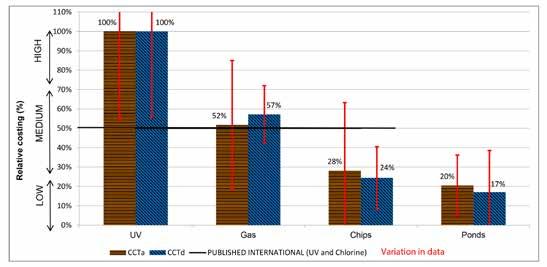
subject for a detailed case study to be presented at the WISA conference in Cape Town in 2019.
Case study by a metro
The relative advantages and disadvantages of various common wastewater disinfection methods have been widely available via open-source resources for some time – e.g. the composite table on page 17 comparing chlorine gas, bleach, calcium hypochlorite, UV and maturation ponds. In the referenced metro study, a similar but far more intensive ‘real world’ approach was taken to compare end-point disinfection between UV systems, chlorine gas, calcium hypochlorite tablets/chips, and natural bioremediation dams at 26 wastewater treatment works (WWTWs). In order to fully cost these systems, metrics such as electricity, chemical use, service and maintenance, and staff training
were included, making this case study the most comprehensive of its kind in recent memory. Here follows selected excerpts from the WISA presentation:
CCTa is the actual flow, while CCtd is the design flow. CCTa is the flow used to conduct the study, while CCtd would be the results should the entire capacity of the WWTW have been used.
When analysing the operational expenditure results, it was found that UV disinfection was the most expensive, followed by gas, calcium hypochlorite (chips) and ponds, which were the least expensive.
As shown in Figure 1, the UV cost comprised electricity, maintenance and service expenditure. Gas comprised chemicals, maintenance, service and training. The chips were purely chemical costs and the ponds were maintenance and service.
The performance of each type of end-point disinfection was displayed

in the bacteriological log reduction graph. The membrane (MBR) and active sludge process (ASP) will always be part of the wastewater treatment process
Figure 2 displayed ponds as the least expensive form of end-point disinfection – it is also the least effective form of disinfection. This is because the is no residual disinfection in the water to inactivate bacteria. The ponds are used merely to separate solids. This is also true for UV disinfection: after the water passes through the light source, there is no residual disinfection in the water to inactivate bacteria that may survive or be introduced afterwards.
Calcium hypochlorite chips were proven to give the best log reduction. When there is a chlorine residual in wastewater, the oxidation cycle has been completed – bacteria is unlikely to be found in the water.
Conclusion
The case study highlighted that by merely pricing disinfection technologies by R/kg, ponds technology would be the best option, followed by chlorine gas, UV and then chips. However, there was a significantly different outcome when working out costing using R/ ℓ and considering maintenance, electricity, training and servicing. Furthermore, these results indicate that municipalities would not only enjoy significant savings but also stimulate low- and semi-skilled job creation, and improved safety if multivariate costing models were applied.
CASE STUDIES
If you would like to find out more about the case studies, please contact Klorman Solutions at info@klorman.co.za.

Teppfa is the European Plastic Pipe and Fittings Association, founded in 1991, and headquartered in Brussels, Belgium. Teppfa’s 13 multinational company members and 15 national associations across Europe represent 350 companies that manufacture plastic pipes and fittings. The association’s members have an annual production volume of three million tonnes, directly employing 40 000 people, with €12 billion combined annual sales.
Its final products are subdivided into two application groups: aboveground systems for hot and cold-water supply, surface heating and cooling, and wastewater discharge; and below-ground pipe systems for sewers, stormwater management, and the distribution of drinking water, gas and telecommunications.

WTeppfa – the European Plastic Pipe and Fittings Association – commissioned the Sewer Installation Time (SIT) project to compare the installation time of sewer systems.
ithin two parallel prepared trenches, a plastic and a concrete sewer pipeline were installed simultaneously by independent contractors with experience in plastics and concrete installation, respectively.
Approach
Regarding the installation technique of the project, 90 m of pipe and two inspection chambers were installed in a 2 m deep trench, whereas 20 m were backfilled. The trench was properly prepared to secure the accurate and safe installation of the pipelines. Trench support systems were not necessary and therefore not included in the project. The installation of the pipe systems was performed in accordance with the applicable EN standards.
Since the installation of a complete sewer system was impossible, an Environmental Product Declaration functional unit (FU) was used for the project. The decision was to install a nominal diameter (DN) 300 mm thermoplastics pipe system in the FU and a DN 300 mm concrete pipe system.
The project was executed under the same site logistics (location, equipment, trench, weather, contractor and video shots), and was video and time recorded. The two videos were run in tandem to depict the difference in installation time between plastics and concrete sewers.
Conclusions
“The time for a plastic sewer system to be installed is 30% less than the time for
What pipe has a quicker installation time?
an alternative material to be installed. To demonstrate, contractors needed 21 minutes to install the first concrete chamber and pipe, and 16 minutes to install the first plastic chamber and pipe. For a total installation of 90 m including two chambers, the plastic system was installed 30% faster than the concrete one and, as a result, 1 hour 53 minutes was the time saved,” explains Zoran Davidovski. In addition, and with regard to the limitations for each product, the installation of concrete sewers depends on the excavator speed, and the installation of plastic sewers more or less depends on the man in the trench. The excavator is also used for lifting the concrete pipes (causing a bottleneck) and is not needed for plastics.
Several other invaluable findings have emerged from the SIT project:
• Less site transport is needed for plastics’ installation thanks to long pipe lengths.
• The positioning in-between and of the last chamber/manhole is more accurate and easier to realise with a plastic system.
• While installing plastics, the excavator was waiting for the man in the trench to finish levelling, bedding and adding lubricant; while installing concrete, the man in the trench had to wait for the excavator, which had to lift and support pipes, and was needed for the pipes’ jointing.
• Lifting equipment is not needed to install plastic chambers, but it is essential in installing concrete manholes.
• Plastics need sand-bedding, which can be time-consuming and difficult to

arrange; however, one can easily de-level the pipe by adding sand support on either side.
• The backfill activities and time for both pipe systems are identical.
• Apart from the speed and ease of installation, plastic systems have 75% fewer leaks than concrete ones, too. “The SIT project provides evidence of how plastic piping systems, which are available in various types and sizes, fulfil customers’ performance needs,” Davidovski concludes.

Plastics need sand-bedding, which can be time-consuming and difficult to arrange, but one can easily de-level the pipe by adding sand support on either side
Blue Drop and Green Drop certification programme revitalised
In a bid to achieve excellence in drinking water and wastewater quality management, the Department of Water and Sanitation is set to conduct a full 2021 Green Drop audit and Blue Drop progress assessment . By
Kirsten Kelly
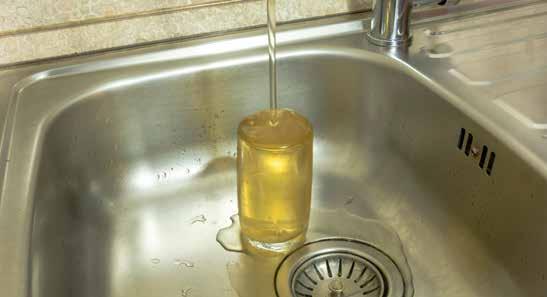
This is one of the most important days in the Department of Water and Sanitation’s (DWS’s) 2021 calendar year,” said Sputnik Ratau, the DWS’s acting chief director for communications at the Green Drop and Blue Drop certification programme
TABLE 1 Key programme dates
Regional symposiums
Distribute Blue Drop PAT
webinar, where its revitalisation was announced.
Mentioned in President Ramaphosa’s State of the Nation Address and part of the National Water and Sanitation Master Plan to establish water security for the next 50 years, the Blue Drop and Green Drop certification programme
WSIs to upload portfolio of evidence (POE) Mid-August 2021
Start audits and site visits
Moderation
Completion of Blue Drop PATs
Confirmation virtual audit
Final moderation
Release ready report
August 2021
August 2021
Mid-November 2021
October 2021
December 2021 December 2021
March 2022 March 2022
THE FIVE STEPS TO GREEN DROP CERTIFICATION:
1 Capacity Management: process control, maintenance, technical/ engineering and scientific
2 Environmental Management: wastewater risk abatement, effluent quality monitoring, sludge management, laboratory credibility
3 Financial Management: wastewater operations cost determination, energy demand, operations and maintenance budget and expenditure, supply chain management
4 Technical Management: WWTW design capacity, process/audit condition assessment, sewer main inspection, asset register, local regulation
5 Quality Compliance: monitoring information, authorisation, effluent compliance sludge classification
will protect the health and well-being of people and the environment, and improve water services and resources through regulation.
Incentive-based regulation
Leonardo Manus, chief director: Regulation, Compliance and Enforcement at the DWS, said that the certification programmes are part of incentive-based regulation. “This type of regulation is all about the people who take responsibility for wastewater management. It is not a weaker form of regulation. It does not mean that the certification programme is voluntary. The National Water Act (No. 36 of 1998) states that the DWS has a right to information that assists it in its duties – meaning that if the DWS asks for information and it is not forthcoming, that is an offence.” Manus went on to say that the certification programme aims to create
an enabling environment for improvement, compliance and efficiency. “It will provide an official recognition to excellence; it is to inspire, not to punish.”
Green Drop
Risk management is core to the Green Drop certification programme. Knowing the risks in the wastewater and sewer collection space makes it easier to manage. The DWS and Water Research Commission (WRC) have developed the wastewater risk abatement plan to assist with risk management.
“Municipalities and water service institutions (WSIs) have to manage these risks. It is simply not sustainable for the DWS to constantly intervene in terms of section 63 of the Act,” adds Manus.
Blue Drop
The Blue Drop Progress Assessment Tool (PAT) deals with the core business of providing quality drinking water to the public. It is used to assess or identify a risk within the water supply syste m. A risk rating will then be allocated and used to inform the DWS o f areas that are excelling and areas that need to reduce risk fur ther.
There are three key areas that will be evaluated for risk:
• water treatment infrastructure
• people who are appointed to operate and manage that infrastructure
• water risk and quality compliance.
These risks should be identified and mitigated before water becomes non-compliant with standards. The Blue Drop PAT should help municipalities and WSIs to plan and understand thei r water supply system. It is designed to identify an area that ne eds improvement. The Blue Drop risk rating should not be confused with Blue Drop performance; however, Blue Drop performance cannot be achieved without a Blue Drop risk rating.
Project plan
The DWS will be working with National Treasury, the Department of Cooperative Governance and Traditional Affairs, and the South African Local Governance Association to make the programmes as impactful as possible.
Both the Green Drop audit and the Blue Drop PAT will be rolled out as soon as possible in order to attain a baseline of water and wastewater management. However, timelines will be slightly more relaxed to allow WSIs to gear up for the process. The final rep orts need to be completed in time for the WSIs’ budgeting processes.
“South Africa’s Green Drop and Blue Drop certification programme is internationally recognised and has been replicated in other countries. It facilitates evidence-based decision-maki ng and in making the correct types of investment. This is part of creating a knowledge-driven economy,” says Dhesigen Naidoo, CEO of the WRC.
He adds that the programme is a perfect example of cooperative governance, where different spheres of government involved in water management work together to build up a system collectively.
“This is also about civil society. This will help citizens understand the state of the water system and work out the contribution that they can make (negatively or positively) to water security in their local environment, provinces and nationally. It will create an empowered citizenry and encourage active participation. We will mark 2021 as an inflection in the water industry.”

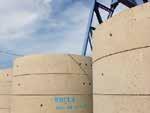
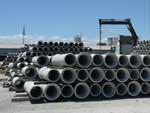
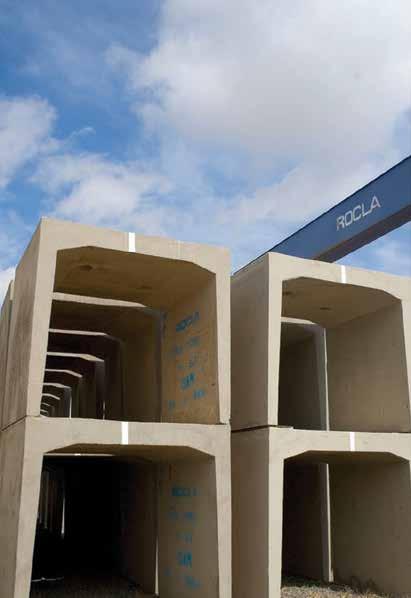
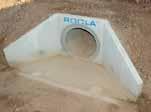
A STRONG FOUNDATION FOR INFRASTRUCTURE SUCCESS
ROCLA is South Africa’s leading manufacturer of pre-cast concrete products.
Surpassing 100 years of product excellence.
• Pipes
• Culverts
• Manholes
• Poles
• Retaining walls
• Roadside furniture


Groundwater: hidden but never forgotten
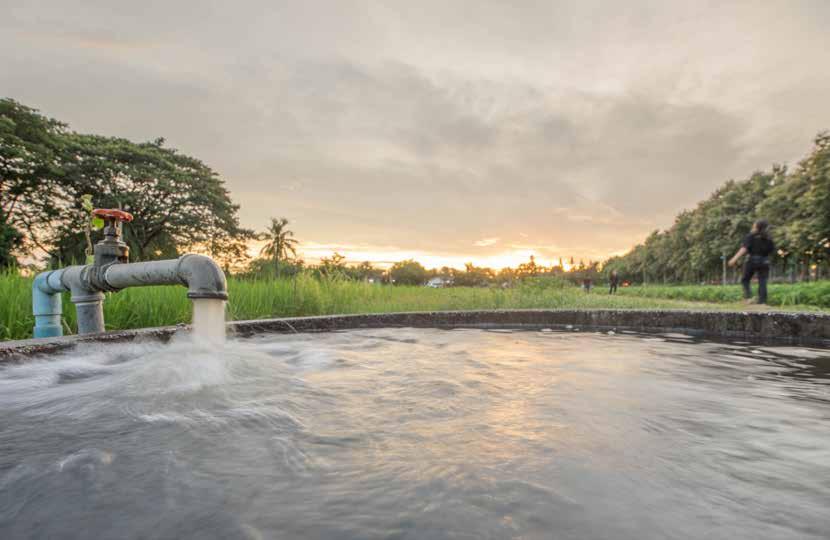


How much groundwater is used in South Africa?
FF Between 13% and 16% of the nation's total water supply originates from groundwater. However, this would exclude all boreholes that are not registered at the Department of Water and Sanitation.
YW In some areas, groundwater provides up to 100% of the water supply.
How much local data is available on groundwater?
FF The DWS monitors approximately 1 800 boreholes around the country and has issued in the order of 25 000 wateruse licences. As a borehole user, it is
Part of the Geological Society of South Africa (GSSA), the Ground Water Division (GWD) is a body of scientists and technicians who have an interest in the optimal development of South Africa’s groundwater as a limited natural resource.
important to monitor your own borehole water quality and levels.
YW The Water Research Commission developed a study called the Strategic Water Source Areas (SWSA) of South Africa, showing that 50% of the water comes from just 10% of the land area. There are 57 SWSA-gw (groundwater) – about 11% of South Africa’s total water – with 37 of these being nationally strategic. The SWSA-gw supply 32% of the settlements that get more than half of their supply from groundwater (and house 4% of the national population). They supply 44% of the groundwater for agriculture, and 32% of the groundwater used for industrial purposes in South Africa. Groundwater is also the main source of water for a further 268 settlements in South Africa. This is significant.
Is groundwater an underutilised resource?
FF Yes and no.
Yes, because 7.5 billion m3 per annum of groundwater is available and there is 10 billion m3 per annum of surface water, but almost all of the surface
water is fully allocated. Around 19% of all groundwater is found in KwaZuluNatal, but most of the province’s water is sourced from a river or a dam. Groundwater is definitely underutilised in KwaZulu-Natal.
South Africa is currently using around 50% of available groundwater and still can develop the other 50%. But if a community has a river, it will not go to the expense of drilling a borehole to utilise available groundwater. There is around 2 billion m3 per annum of groundwater that can be developed. On the other hand, groundwater is not underutilised. In fact, it is overutilised in places like the Karoo.
Groundwater has massive potential. Cape Town will be pumping roughly 10 Mℓ/day of groundwater. Once Port Elizabeth’s groundwater scheme is in place, roughly 15% to 20% of all its water will come from groundwater. Groundwater in Brandvlei in the Karoo is pumped as far as 50 km from the town. Many towns and communities are supplied solely from groundwater. In certain cases, we can utilise more groundwater; in other cases, we need to focus on protecting our groundwater.
Groundwater protection zoning is aimed at safeguarding the quantity and quality of groundwater. A community cannot live on top of a wellfield. Petrol stations or ventilated improved pit latrines should not be close to a borehole. In some cases, development needs to be reconsidered if groundwater earmarked by the municipality for community use will be impacted if the development goes ahead.
YW Typically, we find groundwater in abundance where we don’t need it; and where we need groundwater, we don’t have it. This is due to the complexity of the geology, hydrogeology and variability in rainfall.
With water security as a priority, why is groundwater underutilised?
YW The development and management of groundwater does not reflect its importance. The development of the resource is left at the mercy of municipal procurement and poor operations and maintenance. Groundwater, unlike surface water, requires constant monitoring and maintenance of the infrastructure. A lack of groundwater resources is often blamed for service delivery issues when poor development, operations and maintenance are the root causes.
Groundwater is underutilised owing to the following:
• high cost and complexity of assessment – the myth that groundwater is where you want it to be and it is clean and cheap needs to be scrapped from our textbooks
• dispersive resource makes for high monitoring costs – we need to see it as high-capital items in our spheres of implementation
• resource invisibility and time lags of observing resource impacts
• highly variable aquifer vulnerability to contamination
• near irreversibility of aquifer contamination.
What needs to be done to further develop groundwater?
FF Municipalities and private individuals need to follow the correct procedures when exploring for groundwater. It needs to be done in a professional manner and it is important to use a registered professional. The GWD has a large database of registered professional hydrogeologists that can assist (visit https://gwd.org.za for the database). Also, an uncertified driller may damage or destroy an aquifer. I have seen cases where the borehole was not sealed off properly; it started to leak, and pollution entered the aquifer. And then it is not available for anyone to utilise. A professional will also establish how much should be pumped out of the borehole and for how long, because if it is over- or under-pumped, the aquifer can be damaged.
YW There needs to be an exploration and assessment programme (hydrocensus, geological review, geodynamics, strain analysis). One should never target a potential site blindly with a drilling rig. We need a mindset shift that sees groundwater not as an emergency water supply but a long-term, sustainable solution to water security issues.
How can we better manage groundwater?
FF Groundwater management seeks to balance and mitigate the detrimental
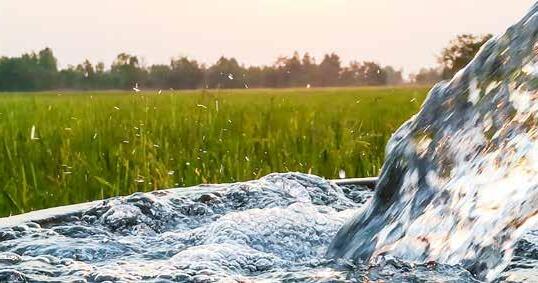
impacts of the development and operation of groundwater. There are a number of elements to consider:
• Protect the wellfield: If people are living on top of your aquifer, there is a high likelihood that it may be polluted. The wellfield needs to be fenced off. But for maintenance and daily operations, there must be easy access to the borehole.
• Planning: There may be a possibility that one requires more water from the borehole than can be extracted. It may take two to four years to get another groundwater scheme up and running.
• Maintenance: Often, when a borehole is not working, it is because a pipe broke, or there is a power issue, a stolen cable, or faulty pump or tap.
• Daily operations: Water levels need to be measured daily. If no one knows how much water has been extracted, and how much the aquifer has been replenished, the borehole may dry out.
• Groundwater education: The community using the borehole water needs to understand where the water is coming from, how much water can be used, and how to avoid polluting the aquifer.
The GWD is available to provide help and technical advice.
GROUND WATER DIVISION (GWD)
• Established in 1978
• Essentially a non-profit association, it is committed to upholding and promoting professionalism in the field of groundwater among its membership
• The GWD is a community of professionals who help South Africans understand and manage groundwater
• The 17th biennial Groundwater Conference will be held between 17 and 20 October as a hybrid event, broadcasting from Gauteng
• The GWD focuses on networking, knowledge transfer as well as capacity and awareness building through initiatives such as conferences, seminars and courses, talks and media relations, publications and sponsorships
• It has a large database of registered professional hydrogeologists
For

The process of pumping liquids and controlling these with valves is a carefully designed one where parameters such as flow rates, pressures, temperatures and a host of other factors are carefully monitored, measured and controlled.
On plants designed to run as 24-hour operations, like wastewater treatment works, any sudden or unscheduled shutdown could place unexpected strain on the system. For this reason, the starting and stopping/shutdown of process plant equipment should always adhere to original equipment manufacturer specifications. However, where unscheduled stoppages do occur, it is important to troubleshoot the system to check for possible faults. Preventative maintenance may be required.

INDEX TO ADVERTISERS
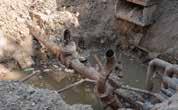

UNSCHEDULED SHUTDOWNS AND PROCESS EFFICIENCY
“Performance can be severely impacted and even a single digit decrease in the system’s productivity can have a vastly detrimental effect on a company’s bottom line,” explains Hugo du Plessis, senior project engineer, KSB Pumps and Valves.
Recommission the pump circuit “As plants are brought back into operation, it is necessary to recommission the pump circuit to be sure it is optimal. This investment in time can prevent further problems down the line,” he continues.
“Hardening of materials, corrosion, leaks, etc. can start during these times and are best dealt with up front. The medium being pumped also dictates how long materials can be stationary before deteriorating the system. It is probably a good idea to have an audit of your system to ensure it is still optimal,” adds Du Plessis.
KSB Pumps and Valves is a leader in the supply of pumps, valves and services for almost every application. The company’s
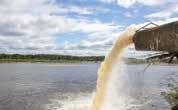
products range from water pumps to advanced petrochemical and pumping systems for energy, mining, industry, waste handling and other applications.
10
KEY MAINTENANCE CHECKPOINTS
• Mechanical pump seals
• Bearings
• Suction and discharge pump casings and flanges
• Valves and valve seals
• Control instrumentation
• Performance curves
• Pump impellers (corrosion)
• Ensure paperwork is updated for improved reporting
• Overall condition of piping
• Instrumentation, gaskets and elastomers (e.g. manometers, flow switches, temperature probes, accelerometers, etc.)
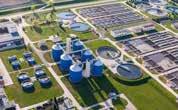
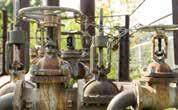
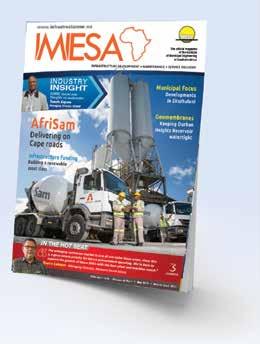

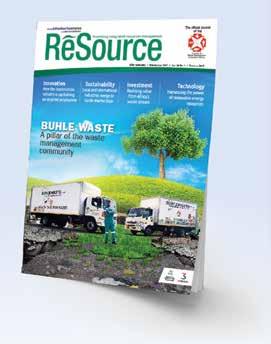



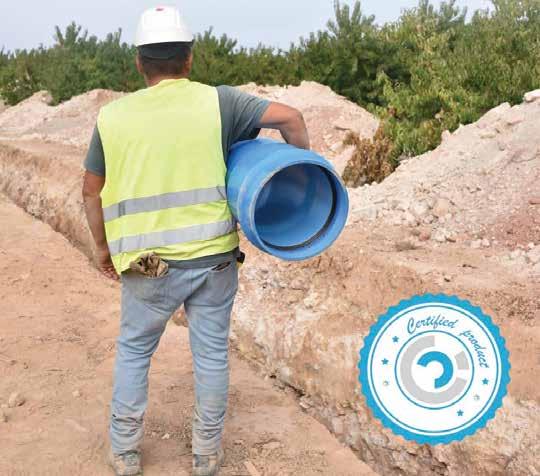
Installation Advantages
Light material | Easy to connect | Higher installation performance | Easy to adapt solid concrete blocks to trench conditions when needed
Advantages During Use
Total water tightness | Less breakages & less leakages | Immune to attacks from micro and macro organisms | Immune to any % of chlorine | Reduced head loss in bends
Advantages for Users
No biological corrosion, water remains always unaltered | No external corrosion proceeding from the soil | Total water quality | Environmental friendly
New diameters of the ecoFITTOM PVC-O fittings
Molecor, in its continuous commitment to providing the most advanced solutions for the conveyance of water under pressure, has recently incorporated new references to its range of ecoFITTOM® Oriented PVC fittings that will contribute to significantly increase the possibilities in the design and execution of networks. In this range extension there are DN125, DN140 and DN225 mm fittings in all the figures already manufactured by Molecor: 11.25º elbows, 22.5º elbows, 45º elbows, 90º elbows, reducers, couplers and sliding couplers. The DN225 diameter is currently available, while the DN125 and DN140 will be available month by month before the end of the year. With the ecoFITTOM® fittings, unique in the world in PVC-O, Molecor offers a continuous system in this material; a continuity that guarantees the same hydraulic and mechanical properties in the different elements of the network, in the pipes as well as in the fittings, thus ensuring the total quality of the transported water. These fittings can be used in networks for the transport of drinking water, irrigation systems, industrial applications, reclaimed water, fire extinguishing networks, etc. among other applications.


